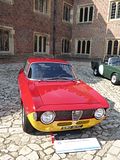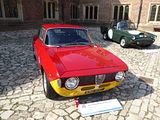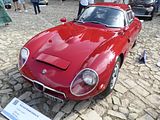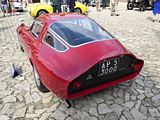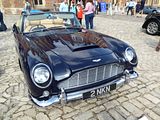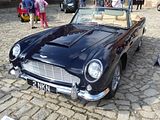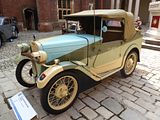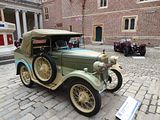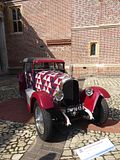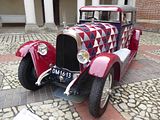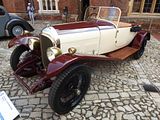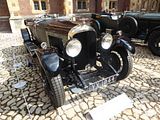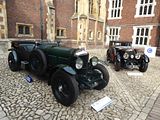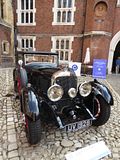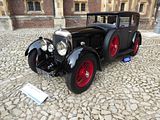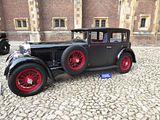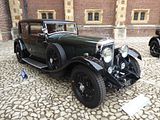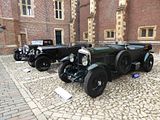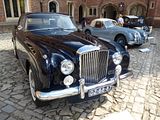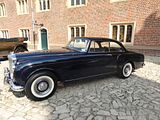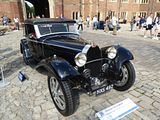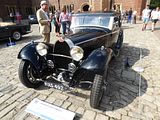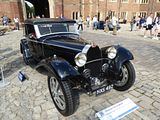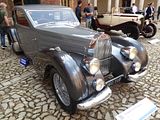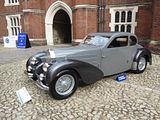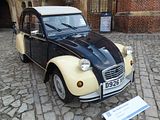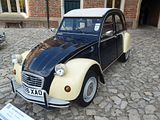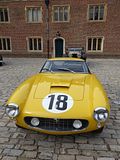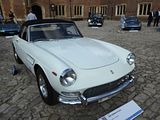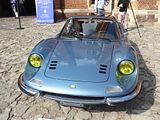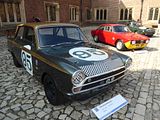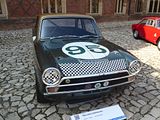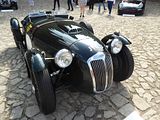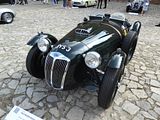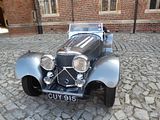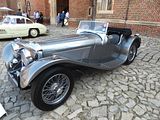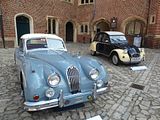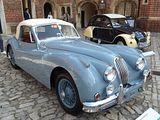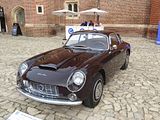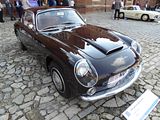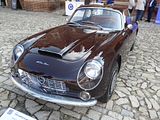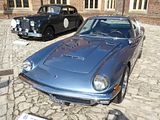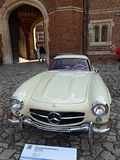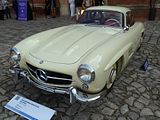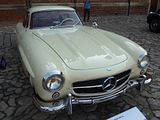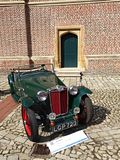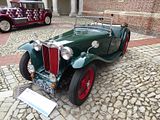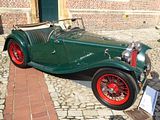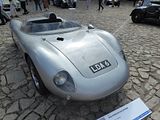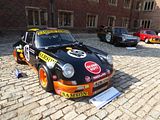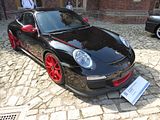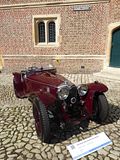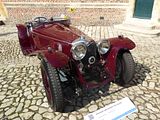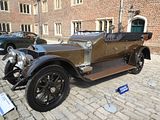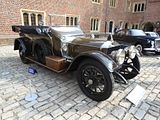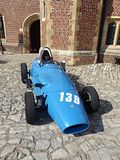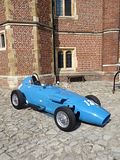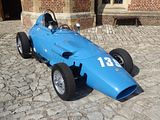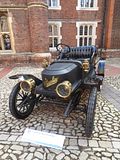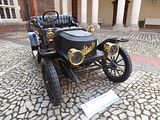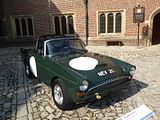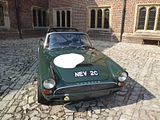At the Hampton Court Concours of Elegance this year, there was an extensive display of the cars being auctioned by renowned Auction House, Gooding & Co. These were displayed in the outer courtyard and made for quite a show in their own right and hence are presented in this separate report.
1965 Alfa Romeo Giulia GTA: Introduced in 1965, the Alfa Romeo Giulia Sprint GTA was one of the first homologation specials. Created to compete in the European Touring Car Championship (ETTC), it was a lighter, more poised version of the Giulia Sprint GT. The “A” was the crucial addition as it is short for Alleggerita, Italian for lightened. For the GTA, Bertone’s Giorgetto Giugiaro-designed body was made from aluminium instead of steel. It was powered by a 1,570 cc, twin-cam and twin-spark engine that produced 113 bhp in street trim, and up to 175 bhp in full competition trim. To meet homologation requirements, Alfa Romeo built 500 GTAs, which included the Stradale road cars and the Corsa racers. On track, the GTA was hugely successful, winning the ETTC in 1966, 1967, and 1968. Jochen Rindt also used a GTA to win the inaugural Trans Am Championship. According to a letter on file from the Alfa Romeo archives, chassis AR613556 corresponds to a Giulia Sprint GTA manufactured on August 25, 1965, finished in white with black interior and delivered to Società Francese Alfa Romeo in Paris, France. Like many GTAs, this car was later prepared to compete in historic racing, and under the current ownership, it has competed in the 2005 Tour Auto, among other events. An example of one of Alfa Romeo’s most desirable models, it is eligible for many major events including the Tour Auto and Goodwood Revival St. Mary’s Trophy. This example, which has been prepared under the current ownership, and event proven, would be an accessible candidate for future historic events.
1965 Alfa Romeo Giulia TZ: Alfa Romeos enjoyed tremendous success in the 1920s and early 1930s in distance, circuit, and hill climb events across Europe. However, as WWII approached, German super teams from Mercedes-Benz and Auto Union attempted to overshadow the cars from Portello. Postwar, Alfa Romeo picked up its winning ways with privateers running prewar 8C 2900s. Through the 1950s, private owners kept the marque alive in competition, most notably those who ran Zagato-bodied variants of the Giulietta and 1900 models. One of the most successful series was the Sprint Veloce Zagato (SVZ) cars, which began to appear in 1956. Their achievements attracted the attention of Alfa Romeo, which then commissioned Zagato to create the Sprint Zagato (SZ), as a catalogued model in 1960. The SZ was succeeded in 1963 by an even more specialized car, the stunningly beautiful Tubolare Zagato (TZ). It was named for the new tube-framed chassis it was built around, providing weight savings and rigidity over the SZ. The TZ was built in the shops of Autodelta, the Alfa Romeo factory’s official race team, and immediately became a winner, capturing class honors at the 12 Hours of Sebring, the Targa Florio, the Nürburgring 1000 Km, and the 24 Hours of Le Mans in 1964, as well as winning the Tour de Corse and Coupe des Alpes outright. There were 112 examples of the TZ built, adding rarity to its many redeeming qualities. According to a copy of the original invoice on file, chassis 750081 was invoiced by Autodelta to Alfa Romeo S.p.A. on September 9, 1964, and fitted with engine no. 00068, which it retains today. It was sold in May 1965 to its first owner, Luigi Citeroni of Ascoli Piceno, Italy, and, according to copies of its Italian registration book, the Alfa was registered on Italian plates numbered “AP53000.” The race debut for 750081 was on August 22, 1965, at the Ascoli Colle San Marco, where Citeroni won his class. Citeroni later sold the TZ to fellow Ascoli Piceno resident Barbaro Grelli in 1966, and somewhat uniquely for an Italian racing car in the 1960s, the Alfa would remain in his ownership for 15 years. According to documents on file, which include detailed club records, as well as many period photos, between July 1966 and August 1970, Grelli drove his TZ in 15 competitive events in Italy, regularly placing well in his class. These were highlighted by two entries in the Gran Premio del Mugello in 1968 and 1969, with class finishes of 4th and 3rd, respectively. Fabrizio Arengi of Padova bought the TZ in 1984 and sent it to one of Italy’s foremost restorers, Dino Cognolato, for refurbishing. Sig. Arengi subsequently used the TZ in rallies, which included the 1988 Coppa d’Italia, and the Alfa Romeo was featured in the April 1993 issue of Auto d’Epoca magazine. Alfa Romeo enthusiast Boy Houtman of Gravenhage, Netherlands, purchased the TZ from Arengi in 1993 via A.B. Cars of Padova. In 2011, Mr. Houtman sold the TZ to noted collector Pierre Mellinger of Switzerland, who immediately drove it in the Tour Auto in France, before shipping it to the Alfa Romeo specialist GPS Classics in Parma, Italy. As documented by numerous invoices, GPS did extensive work to the TZ, including rebuilding the engine and gearbox, as well as completing FIA’s Heritage Technical Passport certification. It then traveled to Carrozzeria Quality Cars in Vigonza, Italy, for cosmetic fine-tuning. The consignor acquired this remarkable TZ from Mr. Mellinger after a careful search for an example to use in rallies. Inspection resulted in the body no. 663 being found in multiple places on the car, including the shock mounts, window trim, and the back side of the door panels. Upon purchase, it was taken to Mugello Engineering in the Netherlands for mechanical sorting, and then it received attention to the bodywork by Classic Skills. In its current condition, and with its extensive file of period documents, photos, and correspondence, this TZ may be the most desirable and intriguing example to come to market in recent history. Eligible for events such as the Le Mans Classic and Tour Auto, this incredible Alfa Romeo Giulia gives any prospective buyer a shot at experiencing the legendary performance that has made this model a must-have for the most discerning collectors.
1965 Aston Martin DB5 Volante: One of the most iconic and famous cars of all time, the Aston Martin DB5 debuted in 1963 as a development of the Series V DB4 Vantage. Available in a choice of sports saloon or convertible body styles, the DB5 was slightly longer, heavier, and better equipped than its predecessor. Among its improvements were a new alternator-type charging system, standard tinted glass, electric window lifts, reclining seats, wool pile carpets, twin fuel tanks, chrome wire wheels, an oil cooler, and full leather cabin trim. As before, the platform-type DB5 chassis was handsomely cloaked in lightweight aluminium-alloy body panels built with the patented Superleggera (Super light) technique under license from Italy’s renowned Carrozzeria Touring. Performance of the DB5 was maintained with the Tadek Marek-designed DOHC inline six-cylinder engine upsized to 3,995 cc with a heady 282 hp rating standard and 314 hp in uprated Vantage specification. Early examples of the DB5 utilized a four-speed gearbox, with a Borg-Warner three-speed automatic or five-speed ZF manual unit initially optional, and the five-speed soon became standard equipment. Precise rack and pinion steering and dual-system Girling hydraulic disc brakes on all corners completed the impressive mechanical specifications of the DB5. In 1964, the DB5 found everlasting fame as the mount of a certain secret agent in the epic James Bond film Goldfinger. After production of just 898 cars, the DB5 was replaced in 1965 by the larger and slightly restyled DB6. Just 123 convertible DB5s were made from 1963 to 1965, including a 37-car run as DB5 production was being phased out in favor of the DB6. Interestingly, the now-typical “Volante” name given to Aston Martin convertibles was only applied to the succeeding DB6 and later models. Nonetheless, the open-air body of the DB5 Convertible remains particularly attractive along the short-wheelbase DB5 chassis, making the DB5 Convertible highly sought after by collectors as one of the most desirable classic Aston Martin models ever conceived. This gorgeous 1965 Aston Martin DB5 Convertible, chassis DB5C/1906/R, is a factory-original, right-hand-drive, five-speed example, purchased new on January 20, 1965, by famed actress and BAFTA winner Beryl Reid. She entrusted it to Aston Martin Works Service on three occasions during the late 1960s, the last for collision repairs at 19,339 miles in 1968. In 1973, the Aston Martin was acquired by Bruce G.S. Coles, who retained it for the next 37 years. Having already been refinished during Beryl Reid’s ownership, from the factory-original Caribbean Pearl to Midnight Blue, along with a new gray hood, the DB5 was used briefly for daily transportation before being reserved for use purely on high days and holidays, thereby minimizing exposure to inclement weather. Circa 1980, the engine was rebuilt to Vantage specification with upgraded cams and cylinder head by an Aston Martin specialist. The next owner acquired DB5C/1906/R in May 2010. Shortly thereafter, it received a concours-quality restoration at the Aston Martin Works Service department in historic Newport Pagnell. The restoration commenced in June 2010 and was completed in August 2011, which included addressing the mechanical systems as well as a bare-metal body restoration and refinishing. A new owner joined the DB5’s roster in March 2012 and following purchase, elected to have the DB5 refinished in Gabiano Blue by Spray-Tec Restorations Ltd at a cost of over £25,000. The leather upholstery was beautifully re-trimmed in beige by the late noted craftsman Lincoln Scott. Since restoration, the DB5 has seen only sparing use and has been maintained to exacting standards by DK Engineering. A detailed history file accompanies this exceedingly rare and desirable 1965 Aston Martin DB5 Convertible, including service and restoration records, MOT test certificates, original and reproduction DB5 instruction books, registration documents, and original log book. Also included are a reproduction tool roll and correct-type reproduction tools.
1932 Austin Seven Mulliner Military: Launched in 1922, the Austin Seven, affectionately nicknamed the “Baby Austin” for its diminutive size, celebrates its 100th anniversary this year. The idea of the economical and affordable Seven was conceived by Sir Herbert Austin, following the introduction of the horsepower tax in 1921. Built primarily as an accessible motorcar for the UK market, the Austin Seven was offered in various body styles including touring, saloon, and cabriolet. A roaring success, the Seven had a similar effect on the UK market as the Ford Model T did in America, and the design was licensed across the globe, from Germany and France to the US and Japan. Bruce McLaren started his racing career in an Austin Seven Special and even the Dalai Lama had one delivered directly to Tibet. The Austin Seven’s practical and lightweight design made it adaptable for applications beyond the public consumer market, including in the form of commercial and military vehicles. In 1929, as part of a policy to mechanize the British Army, a number of military-specification Austin Sevens were supplied to the War Department and issued to cavalry regiments, replacing their horses with horsepower. A copy of a photo on file depicts King George V and Queen Mary in 1932 visiting Aldershot, home of the British Army, and notes that their majesties were “greatly interested in the baby car section of the mechanised forces.” These “mechanised forces” were later utilized for training exercises and transport.This particular 1932 Austin Seven Military was bodied by Mulliners Limited of Birmingham, and is believed to be the only survivor of the rare, export desert specification, which were equipped with a special desert cooling system, Ulster-type water pump, larger radiator, four-bladed cooling fan, and large Vokes air filter. These military variants were used in North Africa, Persia, and India up to the early part of WWII. Little is known about the history of this car until around 50 years ago when it was discovered in Yorkshire and rescued and restored by an Austin Seven enthusiast. In 1988, the Austin passed into the collection of respected Austin Seven authority David Morgan. Mr. Morgan spent the next 30 years taking it to Austin Seven gatherings, including D-Day celebrations and the Goodwood Revival, where the car stood in pride of place outside the Drivers Club. In 2003, the Austin Seven underwent repair work which addressed the body and mechanical systems. More recently, the car was painted in a disruptive Caunter Camouflage livery – a combination of specific colours used by the British Army in the Mediterranean and North Africa. It was a project worked on by Mr. Morgan and, following his passing in 2019, completed by the current owner as a tribute. Offered for public sale for the first time in more than three decades, this vehicle represents a rare and unique opportunity in the well-followed Austin Seven world.
1927 Avions Voisin C14 Lumineuse: Having founded an aviation company in 1906 with his younger brother Charles, the pioneering Gabriel Voisin would go on to build over 11,000 military aircraft for France and other countries through WWI. After subsequent exploits in prefab building and aircraft-hangar production, Voisin opened Avions Voisin, which became one of the world’s most dynamic automakers. Revolutionary from the beginning, Avions Voisin’s first production automotive efforts focused on the adoption of the sleeve valve engine architecture patented in 1908 by American Charles Knight. Known for its almost silent operation, these engines were a hallmark of Avions Voisin’s cars until very late in the marque’s existence. Built from late 1927 to 1932, the C14 was an evolution of Avions Voisin’s first six-cylinder car, the 1926 C11. C14s were built with both four-door berlines and two-door coupe bodies, penned by André Noël. The most exclusive of these is certainly the Lumineuse – or luminous – coachwork, as is fitted to the example here. The Lumineuse model was popular with many prominent artists of the era including Maurice Chevalier, Josephine Baker, and Paul Morand, and both Le Corbusier and Rudolph Valentino were Voisin owners in period. This stunning Avions Voisin C14 Lumineuse is believed by the consignor to have been delivered new to Ferdinand Batime of Lyon, France, as noted on a plaque inside the car. By circa 1975, the Voisin was owned by Dutch collector Jan Martens, who kept it for some 40 years before selling it to the consignor in 2015. A great fan of the finest prewar art and automobiles, the consignor found himself inspired by Georges Lepape’s cover artwork on the first British edition of Vogue magazine, which depicts a stylish, female motorist wearing a Sonia Delauney-inspired “simultaneous” dress and leaning on an open Voisin painted in an Art Deco triangle motif. With his Voisin in need of cosmetic refurbishment, the owner embarked on its restoration, which included a variation of this stunning ornamentation being hand-painted by Dutch artist Bernadette Ramaekers. The painstaking work took six months to complete and stands as a testament to both the original design and Ramaekers’ ability with a brush. A true hallmark of Avions Voisin design is the decidedly Art Deco-patterned Paul Poiret fabric used for the interior trimming, which offers a level of flamboyance that tastefully matches the exterior of this example. The C14 was also treated to an engine rebuild by specialist Didier Pacic, which included new cylinder sleeves and pistons. Combining the elegance, ingenuity, and unparalleled artistry that made Avions Voisin legendary, this charming C14 embodies the marque’s best properties in an accessible and usable package that demands serious consideration.
1926 Bentley 3 litre Speed Boattail: Founded in 1919, Bentley Motors Ltd. quickly established a reputation for speed, reliability, and exemplary road manners with its first model, the 3 Litre. Equipped with a monobloc engine, four valves per cylinder, and twin spark plugs and magnetos, its mechanical superiority was validated with victories at Le Mans, but was equally at home off the track. Among the 1,613 of these 3 Litres built over a nine-year production run, less than one-third were Red Label Speed models equipped with the 9′, 9 1/2″ chassis and the higher compression ratio engine. This example, chassis DE 1224, is further distinguished by sleek and believed unique skiff-inspired coachwork by Vanden Plas. Bentley Motors records show delivery of DE 1224 in July 1926 to Car Mart Ltd. of London, to the attention of Mr. Jacobsen, and fitted with Vanden Plas body no. 1309. Vanden Plas records further describe this as a “2/4 seat Boat body,” indicating a dickey seat for occasional passengers. The original owner of YP1048 was Gordon Jeeves of London, followed by subsequent owners in and around London, with James E. Pearce of Kent acquiring it in 1963, the car having suffered an unfortunate accident with its former owner Mr. Campleman. Recognizing the historical significance of the car’s unique period coachwork, Pearce embarked on a restoration of the car, which retains its original drive train. During this period of work Pearce chose to replace the damaged chassis frame with a 9’, 9 1/2” chassis – numbered 330 – from a 3 Litre Tourist Trophy model dating from 1923. In 1967, the car was sold to noted American racer and collector Briggs Cunningham of California, as documented by extensive correspondence on file. This car remained with Cunningham for 20 years until December 1986, when his entire collection was sold to Miles Collier of Florida, in one of the most significant transactions of its kind. Later in 2003, the 3 Litre returned to the West Coast of the US, joining the incredible Bentley collection of noted marque enthusiast Bruce McCaw. The consignor acquired DE 1224 in 2005, and subsequently hired Bentley expert Dr. Tim Houlding to provide a detailed report with recommendations on how to adjust its presentation for the utmost originality. Sympathetic restorative work was then completed in Germany, including new paint and interior trim, installation of a correct windscreen, as well as a gearbox rebuild and numerous other details. Today, the Bentley is stunningly presented in its original colors of ivory and brown, beautifully offset by the mahogany rear deck, running boards, and dashboard. The beige leather interior upholstery provides a tonal presentation that harmonizes perfectly with the wood trim. For the past 55 years, this unique and well-documented Bentley has been part of a number of notable collections, always receiving the proper care it deserves. While this 3 Litre Speed Model provides its next owner with miles of touring satisfaction, its unique coachwork will undoubtedly be admired by all who witness it.
1928 Bentley 4.5 litre Sports Tourer: The Bentley 4 1/2 Litre model was the logical evolution of the race-proven 3 Litre, true to W.O. Bentley’s philosophy of increasing engine size to raise power, rather than stressing an existing engine. The 50% increase in displacement raised horsepower to 110, more than sufficient to garner yet another Le Mans victory for the Cricklewood firm in 1928. The Bentley Motors team of Woolf Barnato and Bernard Rubin edged out formidable competition from an eight-cylinder Stutz in an epic battle with the victorious four-cylinder 4 1/2 Litre model securing Bentley’s third Le Mans win in five years. Bentley unveiled the new 4 1/2 Litre model in October 1927 at the Olympia Motor Show, offering “to those discriminating motorists to whom the joy of motoring lies in fascinating acceleration, high speed, and—Bentley design.” Its four-cylinder 4,398 cc engine retained the dual ignition and four valves per cylinder design, but shared bore and stroke dimensions of 100 mm and 140 mm with the six-cylinder 6 1/2 Litre model introduced in 1926. A wider radiator ensured greater cooling capacity and the increased power was transmitted through an improved gearbox, all mounted typically in the standard 130” wheelbase chassis. Between 1927 and 1931, a total of 667 of the 4 1/2 Litre models were built, including this well-preserved example, chassis TX3235, still carrying its original Vanden Plas Sports Tourer coachwork. Chassis TX3235 was delivered on July 18, 1928 to its first owner, F.B. Landale of Shaftesbury, with a list price of £1,295. This is confirmed in Bentley: The Vintage Years 1919–1931 by marque authority Michael Hay, who additionally lists its engine no. as TX3236. Accompanying copies of Bentley Motors’ records note a D-type gearbox, no. 7088, the 15/33 (3.53:1) rear-axle ratio, and Vanden Plas body no. 1488. Extracts from the Vanden Plas order books identify this body as a four-place tourer finished in black Rexine fabric. Service records indicate Mr. Landale owned the car through 1936. It was then acquired by J.H. Lender of Kensington who retained it until 1948. Chassis TX3235 passed through four other owners in England and, by 1975, was exported to South Africa. It returned to England in 2000, when acquired by David Duckworth of Lancashire. Since 2008, TX3235 has been part of The Timeless Collection and maintained by a professional team in the collection’s workshop. This marks a special opportunity to acquire one of the best preserved Vintage Bentleys, let alone an iconic 4 1/2 Litre with the definitive Vanden Plas Sports Tourer body. The Vanden Plas Sports Tourer coachwork is of the traditional three-door and rear-mounted, spare-wheel design. At the front, the signature Bentley radiator and grille are topped with the winged “B” mascot with Carl Zeiss “Jena” headlamps providing illumination. The black canvas hood is accompanied by a matching top boot and tonneau cover with black Rudge-Whitworth spoke wheels completing the presentation. The interior is finished in leather upholstery in a deep-red tone which contrasts nicely with the exterior colour. The wood-trimmed dashboard contains the full array of Jaeger and Smiths instruments to keep the driver informed of mechanical operation. TX3235’s capable chassis and engine paired with lightweight Vanden Plas tourer coachwork make it an ideal candidate for vintage tours and rallies. Additionally, its presence on the show field is sure to garner appreciation for its dashing appearance, lovely patina, and inherent preservation qualities. When introduced to the public some 95 years ago, Bentley marketing described the 4 1/2 Litre as “a car which will earn the right to be called the leader of all sports cars.” That bold statement was valid in its day and now serves as a challenge for its next owner to discover.
1929 Bentley Speed Six Saloon: Introduced in 1926, W.O. Bentley’s 6 1/2 Litre Standard, or “Big Six,” was developed in response to the growing demand for larger and more luxurious custom coachbuilt bodies. In 1925, a prototype was tested on the Continent and while returning across France, a chance encounter with a Rolls-Royce new Phantom prototype, also on test, convinced W.O. to raise his new model’s engine displacement from 4 1/2 to the definitive 6 1/2 litres. Intensive development brought the Speed Six version of the 6 1/2 Litre chassis, debuted at the October 1928 Olympia Motor Show, and uprated to 160 bhp with twin SU carburetors and higher compression. The Speed Six was available in three wheelbase lengths measuring 138”, 140.5”, and 152.5”, plus the Le Mans-specification racing cars – the last of the Speed Six line. Naturally applied to racing in the Bentley tradition, the Speed Six proved dominant, sweeping the first four places at Le Mans in 1929 and scoring 1-2 there in 1930. The mighty Speed Six was also highly effective on the high banking at Brooklands, winning the legendary 500-mile race three times straight from 1929 to 1931, cementing the Bentley legend forevermore. Just 182 Speed Six chassis were built in all and, in addition to their rarity, they are particularly admired by Bentley experts and owners for their abundant, turbine-like power delivery and brilliant racing legacy. The most discerning and enthusiastic owner-drivers of the era selected the Speed Six for their personal transportation and many of the world’s finest custom coachbuilders of the era applied their artistry to the Bentley chassis. Highly ranked among them was Freestone & Webb of Willesden, northwest London, a short distance from Bentley’s Cricklewood works. Established in 1923, Freestone & Webb were leading British exponents of the unique fabric body construction system introduced in 1921 by Charles Weymann’s Carrosserie Weymann of Paris. Carrying exceptional originality, this Speed Six, chassis FR2644, is a wonderful example of Weymann’s patented body-construction process. Built on the short-wheelbase chassis, FR2644 is one of 121 Series 2 chassis and features the handsome “Six Light” Sports Saloon body style by Freestone & Webb. Documented and depicted in marque expert Michael Hay’s definitive book, Bentley: The Vintage Years 1919–1931, FR2644 was equipped new with engine no. FR2648, registered UV 1928, and delivered in July 1929 to Captain C. Davaynes Smyth. The next documented keeper of FR2644 was Bentley Drivers Club (BDC) member Frederick James Edwards of Kent, who joined the Bentley’s roster in September 1950. The rare Speed Six was an obvious pride and joy for Mr. Edwards, who ensured it remained in very well-maintained and highly original condition throughout his ownership, which included a documented outing with the BDC contingent in attendance at the Vintage Sports Car Club (VSCC) Goodwood meeting in 1955. The successor to Mr. Edwards was Richard Sanders of Bicester, who took ownership in August 1993 via a classic vehicle dealer in Sussex. According to Mr. Hay’s 1997 update of his vintage Bentley text, FR2644 still retained its original Weymann-type body and individually numbered Elektron deck (running) boards at that time. An early promotional photo of FR2644 also appears in the 1999 book, Halcyon Days: Recollections of Vintage Motoring, wherein it evoked memories of a similar car sighted while mustering for military service during the early 1950s by author Rodney Dale. As offered, FR2644 maintains incomparable integrity, continuing to benefit handsomely from sympathetic preservation throughout its life. Retaining the original Weymann-type Freestone & Webb body, even down to the Rexine covering, FR2644 is powered by its matching-numbers engine per factory documentation. The handsome and sporting Speed Six is highly attractive with its close-coupled, Weymann-style coachwork. The unique body has many attractive features including a peaked-roof valance at the top of the windscreen, two underfloor storage lockers on each side of the coachwork that are accessible only when doors are open, and individual, adjustable front seats, which indicate this car was intended for the owner/driver rather than a more staid Saloon style with a division. Charming details are present on this Bentley throughout, including the original Weymann patent tag still affixed to the coachwork and the beautiful Grebel center driving lamp mounted between the imposing Lucas headlamps. Unquestionably eligible for the concours lawn and many of today’s most desirable vintage rallies and touring events, this 1929 Bentley Speed Six is accompanied by historical information and even the 1950–1967 logbook. It exemplifies prewar motoring with its wonderful preservation, adventurous looks, and powerful, turbine-smooth 6 1/2 litre powerplant that made the Speed Six the favorite of company founder W.O. Bentley’s legendary motorcars. FR2644 has been part of The Timeless Collection since 2006 and has been maintained by a professional team in the collection’s workshop. Kept alongside other significant prewar automobiles, this marks a singular opportunity to acquire one of the best preserved Vintage Bentleys.
1932 Bentley 8 litre Sports Saloon: Sharing its basic concept with the prior 6 1/2 Litre, the Bentley Eight Litre of 1930–1931 continued the trend of providing ever-more powerful engines and massive chassis capable of carrying the new crop of luxurious custom bodywork without sacrificing performance. Featuring single overhead camshaft architecture with four valves per cylinder and a lightweight Elektron magnesium alloy crankcase, the eight-litre powerplant reflected the latest in design and engineering. The new, heavily reinforced chassis was equally sophisticated, utilizing “one shot” Tecalemit lubrication, Dewandre servo-assisted brakes, and Bentley & Draper friction dampers up front with hydraulic dampers to the rear. To say the Eight Litre succeeded in its mission would be a severe understatement, with the last motorcar engineered and developed under company founder W.O. Bentley delivering some 220 hp in uncanny silence while capable of accelerating without complaint from walking speed to 100 mph in top gear. Built only as a bare chassis and priced from £1,850, the Eight Litre was superlative in all respects and substantially more costly than its direct competitor, the Rolls-Royce Phantom II. Just 100 examples of the mighty Eight Litre were built. Offered in 144″ and 156″ wheelbase lengths, the Eight Litre exuded a commanding presence with a wide array of body styles supplied to exacting customer specifications by the era’s finest custom coachbuilders. As with its other Vintage Bentley stablemates, the Eight Litre continues to enjoy high regard from collectors and marque enthusiasts from new, with histories carefully tracked and abundantly documented. This 1932 Bentley Eight Litre, chassis YX5110, is certainly no exception, carrying excellent provenance and benefiting handsomely from collector care throughout its lifetime. Delivered new in June 1932 by Jack Barclay to H.W. Reginald Room of Bromley, Kent, and registered as GY 3903, this Eight Litre was built with the long 156″ wheelbase chassis and fitted with elegant, close-coupled Sports Saloon coachwork by H.J. Mulliner. Chassis YX5110 was maintained and serviced throughout Mr. Room’s ownership prior to acquisition in 1940 by fellow Bromley resident H.W. Poultney, who retained the Eight Litre and eventually disassembled the majestic Bentley and carefully packed the parts and components in advance of a planned restoration. Mr. Poultney’s wife took ownership of the Eight Litre after her husband’s passing in the early 1960s and she eventually sold it in June 1971 to famed automobile manufacturer and racing team owner Peter J. Agg. As he later related to a writer for a November 1974 Thoroughbred & Classic Cars magazine article entitled “Bentley 8-Litre,” the body and chassis were separated, the rest of the car’s components and parts filled 18 tea chests and “the only part missing was the wiper motor.” Following the acquisition, Mr. Agg commissioned his Trojan Inc. staff to restore the grand Bentley to concours standards. Following completion of the year-long restoration, YX5110 was shown at a succession of Bentley Drivers Club (BDC) meetings and other shows and events in the UK. This tradition continued under the next owner and BDC stalwart, J.D. “Jimmy” Medcalf, who acquired the Eight Litre in 1979 and retained it until 2007, when it was acquired by noted British collector and vintage racer Jonathan Turner. As offered, YX5110 maintains impeccable integrity, retaining its majestic coachwork and with a beautifully patinated interior. Power is delivered by the matching-numbers engine and gearbox, according to factory documentation on file. In more recent times, it was expertly finished in the very attractive two-tone green and black color scheme. In addition to its twin driving lamps and dual side-mounted spare wheels and tires, the Eight Litre is richly equipped with rear vanity sets, pull-down rear picnic trays, an opening sunroof, a rare and unusually extensive tool kit, and a fabulous dashboard containing a full array of instruments, including the highly unusual Tapley Gradient Meter. A comprehensive dossier accompanies the vehicle, including a Bentley Motors Eight Litre catalogue, a correct handbook, articles, correspondence, and the old-style buff registration logbook. Since 2010, YX5110 has been part of The Timeless Collection and maintained by a professional team in the collection’s workshop. Kept alongside other significant prewar automobiles, this Eight Litre Sports Saloon represents a singular opportunity to acquire an outstanding Vintage Bentley. A fitting swan song for Bentley Motors, the Eight Litre captivates and amazes all who experience it directly with its grandeur, luxury, and decidedly athletic presence. With its exceptional integrity and outstanding condition YX5110 offers a fabulous way to partake in the W.O. Bentley magic.
1932 Bentley 8 litre Sports Tourer: Following four consecutive wins at Le Mans, Bentley introduced its magnificent Eight Litre model at the Olympia Motor Show in October 1930. While early marketing efforts emphasized its broad range of qualities including performance, silence, safety, reliability, strength, and comfort, true to its racing heritage, its capability on the road remained its strongest attribute. A December 1930 Autocar magazine review summarized it as “motoring in its very highest form” and went on to remark that “the dominant note of the new Bentley is its tremendous performance.” Its massive engine incorporated the latest technology, including four valves per cylinder, dual ignition, and a crankcase made of Elektron alloy, and was conservatively rated at 220 hp. A double-dropped chassis reduced height and lowered the center of gravity, and was reinforced with seven cross members. This combination delivered on W.O. Bentley’s desire to produce “a dead silent 100 mph car.” Priced at a lofty £1,850 for the chassis alone, just 100 were built before the Vintage Bentley era came to an end. Chassis YM5036 completed testing in May 1932 and was delivered to Arthur R.B. Owen through the Jack Barclay dealership in London. As a YM chassis, it was part of the third of four series built, and its as-delivered, 13-foot chassis was originally fitted with Wylder open two-seater coachwork. Nora Hardy MacCaw, who owned several other significant Bentleys including the famous 1931 4 1/2 Litre supercharged “Green Hornet,” acquired the car in 1933, after which it passed through a number of owners in and around the London area. Collector H.L. Good acquired YM5036 in 1946 at which time the car was reported to have traveled just 25,000 miles. Mr. Good modified the car by shortening the chassis to 12-foot specifications, removed the Wylder body, and affixed drophead coupe coachwork from a Hotchkiss on the chassis. He later separated that body for use on a Rolls-Royce chassis with the Bentley chassis placed into storage where it remained until his passing in 1991. Showing 31,000 miles on its odometer at that time, the chassis was sold to marque expert Stanley Mann, who embarked on the creation of Le Mans-style tourer coachwork, a most fitting design for the short-wheelbase chassis. This exhaustive four-year effort was carried out with stunning results. In 2006, the current owner added YM5036 to his noteworthy collection where it has been enjoyed and received the proper care it deserves. The rakish sports tourer coachwork features a three-door fabric body fitted with dual side-mounted spares. Its body is finished in traditional British Racing Green with matching green hides used on the four-place interior. A black canvas hood folds flush with the body and a matching tonneau can be placed over the rear seats, creating an intimate two-seater appearance. The attention to detail in its coachwork is evident throughout the body. A full-width windscreen is supplemented with smaller, separate Le Mans screens for both for both driver and passenger. Protecting the stately Bentley radiator is a screen of the same weave pattern as those placed over each Lucas headlamp. Proper leather straps secure the bonnet and, fitted with these details, YM5036 strikes a purposeful stance. It is estimated that just 80 Bentley Eight Litres are extant today, and each is highly prized not only for its mechanical prowess, but also for its inherent historical significance. These cars marked the end of W.O.’s association with the firm he founded and the high-water mark for Vintage Bentleys. This example represents the ultimate Bentley: a low-mileage chassis configured in the most sporting guise, ready for use on the open road where its performance can be fully appreciated. While the term did not exist in its day, “supercar” in today’s vernacular best describes this rare Bentley, a title most fitting throughout its 90-year life.
1953 Bentley R Type Continental Fastback: With design heritage dating to aerodynamic research conducted at Rolls-Royce during the 1930s, the streamlined Bentley R-Type Continental reasserted Bentley’s legendary performance image and continues as an automotive landmark and true object of desire for collectors today. In the early postwar years, H.I.F. Evernden and J.P. Blatchley were assigned the task of designing a lightweight, aerodynamic, and unabashedly beautiful Bentley capable of carrying up to four adults in comfort and at high speed over long distances in the finest grand touring tradition. After creating some lightweight bodies on the Bentley Mark VI chassis, coachbuilding firm H.J. Mulliner was contracted to design and construct the R-Type Continental prototype, affectionately named “Olga.” Styling was finalized by Stanley Watts of H.J. Mulliner. The body, window frames, and seat structures were of light alloy, resulting in a four-place body weighing just 750 pounds and the complete car less than 4,000 pounds. Aerodynamics were refined by Evernden’s assistant, Milford Read, at the Rolls-Royce wind tunnel, including the reduced frontal area, sleek fastback roofline, and discreet tail fins. Exhaustive road testing resulted in modification of the gearbox to a direct-ratio top gear and a lowered rear-axle ratio for enhanced performance. These modifications provided high-speed touring capability and well-spaced gears for around-town drivability and took full advantage of the Continental’s tuned, 153 hp, 4,566 cc, F-head six-cylinder engine. The world’s fastest production four-seater in 1953, the A-series R-Type Continental was capable of reaching 115 mph. The most expensive production car of its day, the R-Type Continental was hand-assembled, superbly finished, and astronomically priced. A total of 207 were built in all, plus the prototype, from May 1952 to April 1955. Of them, 193 – including this early example numbered BC20A – were fitted with the most desirable Fastback body design by H.J. Mulliner. Interestingly, despite the “20” in its chassis number, BC20A was actually the 19th Continental built, given the marque’s traditional exclusion of the number 13 in its numerical system. According to the copies of factory records supplied by the Rolls-Royce Enthusiasts’ Club (RREC) on file, BC20A was originally equipped with lightweight, adjustable front seats, plus numerous special-order features. Among them were flashing-type turn signal indicators with amber lenses, double-filament headlamps, high-frequency horns with a muting switch, and a speedometer in kilometers, plus twin fog lamps and a radio. While included in the Continental’s price as standard equipment, a radio was normally installed only at the buyer’s request to save weight. Upgraded mechanical specifications included uprated front dampers, special steering gear, a 17″ high-speed cooling fan and unique radiator. Finished in Dark Green over Beige Connolly leather upholstery, BC20A was completed on January 30, 1953, and road tested on February 4th. Next, BC20A was shipped to Switzerland, where it was delivered to its first owner, Louis Schneiter, followed by a high-profile display on the Rolls-Royce and Bentley stand at the Geneva International Motor Show in March 1953. By January 1960, BC20A was acquired by Lamont Haggarty and exported to the US, and subsequently purchased by Anthony “Bud” Korteweg of New Jersey, the founder of The Coachworks, a Bentley and Rolls-Royce restoration specialist. A restoration was completed during Mr. Korteweg’s ownership, and BC20A is believed to have been the last automobile restored for his personal enjoyment. In 2014, the Continental was sold to a new owner in the UK, followed by extensive mechanical servicing performed in 2015 by The Chelsea Workshop in London, with emphasis on preparing the car for regular driving enjoyment as desired. Invoices on file detail nearly £50,000 in work performed on the brakes, clutch, four-speed manual gearbox, and suspension, as well as significant engine work. Further service was subsequently completed by the Rolls-Royce and Bentley marque experts at P & A Wood. Of particular note, BC20A retains its factory-original engine, no. BCA19, per the copies of factory records, and is accompanied by a dossier including articles, registration paperwork, records, and aforementioned RREC documents, plus a tool set. Exceedingly rare, beautifully styled, and handsomely presented, BC20A is unquestionably a design icon and one of the most influential grand touring cars of the postwar era. Ready to collect and enjoy as desired, this 1953 R-Type Continental Fastback exemplifies the Bentley ethos in all respects.
1962 Bentley S2 Continental: Closely related to the Bentley S1, and first cousin to the Rolls-Royce Silver Cloud, the S2 differed aesthetically in its grille design, bonnet profile, and wheel covers. Under the bonnet, the S2 sported the all-new aluminium 6.2-litre, overhead valve, V-8 engine capable of producing roughly 200 hp – a 30% increase over the S1 six-cylinder engine – while achieving reduced fuel consumption. Coupled with power-assisted steering, upgraded brakes, and the Hydra-Matic four-speed, automatic transmission, the newly configured S2 was sportier, faster, and considerably more comfortable to drive than its forerunners. Between 1959 and 1962, a total of 2,308 examples of the Bentley S2 were built, with just 93 carrying two-door coupe coachwork by H.J. Mulliner. This 1962 Bentley S2 Continental, chassis BC87CZ, bears the H.J. Mulliner & Co. Ltd. plate, denoting body no. 6497. A late-production C-series example, this right-hand-drive Bentley is one of the last of the production run. It was delivered new to H. Watson Hall of England, in February 1962, and registered with the license plate “C86BC.” While much of its early provenance is undocumented, it is believed to have been acquired by P & A Wood, Rolls-Royce and Bentley official heritage dealers in England. By 1986, the S2 was in the care of noted collector James K. Dobbs III of Memphis, Tennessee, who bought it for his 40th birthday and toured the UK before importing the Bentley into the US. In 1991, it was in the possession of Morris Gardner of Allison Park, Pennsylvania, who also owned a Flying Spur and two coupes simultaneously, all bodied by the prestigious H.J. Mulliner coachworks. Gardner later sold this Bentley to notable collector and vintage racer Herb Wetanson of Connecticut. Purchased by the consignor in 2019, the S2 joined his extensive collection of European sports and collector cars. Today the Continental is beautifully presented throughout, sporting a refined livery of dark blue paint with fine red pinstriping down its flanks and over the rear wheel arches. The interior carries beautifully patinated original blue leather upholstery and complementary carpeting, highlighting the superb wood dashboard. Stately in every aspect, the S2 features air-conditioning, power brakes and windows, and assisted steering. In current ownership the Continental has received rebuild of its braking and power steering systems, as well as new tyres. Not only is this Bentley a prime example of the esteemed S2 Continental, it is also accompanied by copies of build sheets, registration records, and invoices. Built to last, dressed to please, and engineered to delight, this S2 Continental is the perfect companion for the scrupulous Bentley enthusiast.
1932 Bugatti Type 55 Cabriolet: The Type 51 was the first Grand Prix Bugatti to feature a dual overhead camshaft motor, available in three sizes: 2.3-liter, 2.0-liter, and 1.5-liter, all supercharged. The 2.3-liter version produced as much as 160 hp, and the model soon proved very competitive. The Type 51 won several major races during its first season, and it was a Type 51 that earned Bugatti’s last significant Grand Prix victory against major opposition at the 1933 Monaco Grand Prix. It was from these thoroughbred underpinnings that Jean Bugatti proceeded to develop the Type 55 road car, which soon became one of the most coveted sports cars of the early 1930s. The magnificent 2.3-liter engine retained its supercharger, but was detuned to 130 bhp to ensure tractability while inside still beat the heart of a racer. The price was astronomical, and as a result, a mere 38 chassis were built between 1932 and 1935, almost half of which were fitted with gorgeous Jean Bugatti-designed coachwork. Yet for some, that was not enough as they required something even more exceptional. To satisfy this demand, a number of coachbuilders such as Vanvooren, Figoni, and Gangloff were therefore allowed to create bespoke one-off creations. With its cabriolet body by Gangloff, chassis 55230 is one of these extremely rare and very exclusive Bugattis. According to the Bugatti factory sales records, chassis 55230, fitted with engine no. 15, was ordered by “Vidal-Hoffmann” on April 1, 1932. Alfred “Freddie” Hoffmann, owner of the Nerka spark plug company, operated a Bugatti agency in Marseille, France, with his associate Henri Giraud. Their agency was named Giraud & Hoffmann, and Marcel Vidal was a race car driver and personal friend of Ettore Bugatti. On June 20, 1932, Gangloff in Colmar, France, invoiced Giraud & Hoffmann for a “Cabriolet 2 Places” body. The price was 19,000 francs, and the order stipulated that the top was to be fashioned from Rexine. According to Bugatti historian Mark Morris, in the accompanying report on file, Gangloff records do not refer to chassis numbers. Nevertheless, it was possible for Mr. Morris to identify the individual entry for 55230 as a two-seater Cabriolet, which was built by Gangloff employee M. Scholler and delivered to Giraud & Hoffmann on June 24, 1932. Whilst it cannot be definitively confirmed that Marcel Vidal was the first owner of 55230, the report on file and opinion of Morris is that Vidal likely was. On December 15, 1932, the car was given Paris registration no. 9318-RF7 but, as the records have not survived, the name of its presumably new owner remains unknown. After one or more owners in Paris, the car was next re-registered on November 13, 1935, in the name of L. Courcy in the Seine-et-Oise region close to Paris. Soon after, the car was issued another registration number which it wore until the following November in 1938. At this time, the car was issued a new Parisian registration no. 916-RK which it retained until 1953. While the name of the 1938 Paris owner is unknown, it is possible to trace the car’s chain of ownership going forward. The car was acquired on April 10, 1947, from a Bugatti mechanic named M. Framezelle, by Marcel Cirou, a former Amilcar dealer and race car driver. According to the report of Mr. Morris, Cirou won a race on the Montlhéry racing track on June 8, 1947, in the sports car class with 55230. The car was reported to have driven 100.534 km (62.5 miles) in 54 minutes, 53 seconds at an average 109.9 km/h (68.3 mph). In 1950, a new French registration system was introduced that allocated a two-digit suffix number to each region; Paris being given suffix no. 75. Chassis 55230 was issued plate no. 3124-CK75 and a photograph of 55230 wearing this registration appears in Pierre Dumont’s 1975 book Bugatti: Les “Pur Sang” de Molsheim. Marcel Cirou fell ill circa 1952. He returned to his family in Normandy and left the Bugatti in storage in Paris, likely in the Garage Auber, operated by Pierre Proust. In 1955, chassis 55230 was sold to Bob Estes, a well-known American racing driver who would have been the Bugatti importer and distributor on the West Coast of the US if the company were to resume production. According to Mr. Morris’ report, the Type 55 was likely purchased from a certain Gaston Docime who had put it up for sale with a famous Paris sports car dealership called Les Haras des Pur Sang (The Thoroughbred Stable) owned by François Mortarini. In Hugh Conway’s 1962 Bugatti Register, the car was listed as belonging to R. Estes of Inglewood, California, and was noted as having been bought in Paris in 1955. Mr. Estes registered the car in California and several photos from this period exist showing the unique Type 55 Cabriolet parked in front of Mr. Estes’ dealership, Precision Motors, which he co-owned with Otto Zipper. Over the next few years, Mr. Estes used the car little, while his wife Joy entered it in several concours events. In December 1978, 55230 was sold to Walter B. Weimer of Washington, Pennsylvania. Mr. Weimer dismantled the car over a period of several years, with the intent to do a full restoration that never materialized. In late 2014, he commissioned Alan Taylor to restore 55230 but, before work commenced, sold it to its present owner, a prominent UK-based collector. Under the current ownership, a significant restoration was performed, with the bodywork entrusted to Classic Motor Cars Ltd. and the mechanicals rebuilt by marque specialist Ivan Dutton Ltd. The results of this effort are most impressive, and the Type 55 Cabriolet presents today in concours-quality condition, handsomely finished in black with red leather upholstery, and fitted with a black Rexine top, as was originally specified. Notably, 55230 has not been exhibited at any concours since its restoration was completed, providing its next caretaker the opportunity to debut this unique Gangloff-bodied Type 55 at leading international events, including Pebble Beach, Villa d’Este, Hampton Court, and Chantilly. Chassis 55230 was inspected both before and after its restoration by Bugatti historians Mr. Morris and David Sewell, who completed an extensive and detailed report on the car, which is available for prospective bidders to review. The accompanying report concludes with the following summary: “Overall this is a remarkably original Type 55 Bugatti, retaining as it does all its original mechanical components and its Gangloff coachwork. Its recent restoration work has resulted in it becoming one of the very best examples of this most highly sought after Bugatti model.”
1937 Bugatti Type 57C Ventoux: While many volumes celebrate Bugatti’s legendary automobiles, the importance of the Type 57 cannot be overstated. The marque’s last truly new model line, the Type 57 marked, in the words of author Barrie Price, “the final flowering of the genius of Ettore Bugatti and Jean Bugatti.” Built from 1934 to 1939, the Type 57 heralded a new 3.3-liter, dual overhead camshaft engine and while modern hydraulic brakes were utilized, the Type 57 maintained Ettore Bugatti’s favoured solid front-axle suspension. Development included an improved second series from late 1936, plus the supercharged 57C. Type 57 Grand Prix and sports racers expanded Bugatti’s rich legend on the track, including the Type 57 “Tank” that scored Bugatti’s first Le Mans victory, a feat repeated in 1939. Type 57 road cars were stylish, luxurious, and very fast, with four core body styles designed by Jean Bugatti and mostly built at Molsheim, including the Ventoux coach (two-door sedan), the Stelvio Drophead Coupe, and Galibier four-door, plus the Atalante Coupe. While the Type 57 was an unqualified success for Bugatti, total production only reached 710 examples of all variants. Bearing chassis 57506, this 1937 Bugatti Type 57C Ventoux is a factory supercharged example. Documented by Bugatti historian David Sewell, 57506 was built to an order placed December 10, 1936, by J. Moreau. M. Moreau was an influential Bugatti client who had purchased a 1936 Bugatti Type 57 Ventoux, chassis 57357, directly from the factory, and subsequently traded it back to Bugatti, presumably in exchange for this 1937 Bugatti Type 57C Ventoux, 57506. According to Mr. Sewell’s notes on file, 57506 was completed in April 1937 with engine no. 8C, and according to Bugatti factory coachwork records, the “four-light” (window) Ventoux body was finished in black, trimmed in red leather upholstery, and completed on June 14, 1937, with the invoice issued to M. Moreau on June 22, 1937. Mr. Sewell did not find any additional factory records relating to 57506, leading him to conclude it may have remained with M. Moreau through wartime. According to Mr. Sewell, by 1946, the Bugatti was acquired by Jean Mantoulet, famed inventor of food-processing appliances and founder of Moulinex. In 1955, M. Mantoulet sold 57506 to M. Desmarest, a central Paris resident who retained the rare Bugatti until 1964, when it was acquired by Jean-Louis Bouyer of suburban Paris, who retained 57506 for the next three decades. On June 22, 1995, M. Bouyer sold the Ventoux at 69,000 indicated kilometers (42,875 miles) to a French classic car dealer. Mr. Sewell describes a letter from M. Bouyer to the buyer, noting that the Bugatti was stored during wartime and just 48,000 km were indicated when he purchased it in 1964. Following restoration during the late 1990s, the Bugatti passed in May 2000 through a short-term Belgian owner to Karel Van de Velde, also of Belgium. During this ownership, a complete, concours-quality, body-off-frame restoration was performed, with photographic documentation and detailed reporting by Swiss Racing Engineering SA of Gland, Switzerland. The dual-camshaft, 3.3-liter supercharged engine was rebuilt, run in, and dynamometer-tested at 173 peak horsepower. Of further note, the Bugatti’s interior, dash, and instruments were restored, while the delightfully patinated red leather front seating surfaces were carefully preserved and retained. The current owner acquired the Bugatti in January 2011 and registered it in the UK as “YUB 160.” Concours appearances include the UK Bugatti Owners’ Club Concours d’Elegance held at Prescott in July 2017. Benefiting from service and maintenance by noted professionals since the consignor’s acquisition, 57506 is offered with a wealth of data, correspondence, past and present registration paperwork, operating instructions, detailed restoration records, and the David Sewell report. Pure automotive royalty, in rare factory supercharged specification, this 1937 Bugatti Type 57C Ventoux offers a truly uncommon and thrilling opportunity to join its roster of keepers and share the incomparable Bugatti mystique.
1987 Citroen 2CV Dolly: A special-edition model of the iconic Citroën 2CV, the Dolly was unveiled in March 1985 and originally limited to 3,000 examples. The immediate success of the practical yet charming 2CV led to a second release of 2,000 cars in October of that year, and a final batch in 1986, bringing total production to around 10,000. Powered by a 602 cc, air-cooled flat-twin engine coupled with a four-speed gearbox, the Dolly quickly became the people’s favourite with a cult following. The stylish French two-tone design was easily recognizable in towns and cities not only across the UK, but worldwide. This example was sold new to a woman in Scotland who enjoyed the car locally and accrued limited miles over a 32-year period. In 2019, a prominent figure in the automotive and racing world purchased the car with the intent to transport his children to and from school. An introduction to the “old car scene” in a fun and unpretentious manner, this Dolly has been enjoyed not only by the consignor’s family but countless other people during its years in its current custodianship. Displaying just over 19,000 miles at the time of cataloguing, this 2CV Dolly is being offered for sale once again. Moreover, the consignor plans to donate 100% of his sale proceeds to Ukraine Voices of Children to support families that have been affected by the war in Ukraine. The consignor remarked, “I hope our Dolly can help these families and bring them some comfort, a fine testament indeed to the joy it has brought our family over the years.”
1959 Ferrari 250 GT SWB: At the Paris Salon de l’Automobile, held at the Grand Palais in October 1959, Ferrari unveiled an all-new 250 GT Berlinetta, creating excitement among enthusiasts around the world. Known as the Short-Wheelbase Berlinetta (SWB), the new Ferrari featured a revised 250 GT chassis that had been carefully developed by three talented engineers – Giotto Bizzarrini, Carlo Chiti, and Mauro Forghieri. Distinguished from its predecessor by its shorter wheelbase (2,400 mm vs. 2,600 mm), updated suspension, and four-wheel disc brakes, the new 250 GT Berlinetta featured attractive coachwork designed by Pinin Farina in Torino and constructed by Carrozzeria Scaglietti in Modena. The new 250 GT SWB Berlinetta was available in road-going form, with steel bodywork, or in full competition specification, with lightweight aluminum coachwork. The alloy-bodied cars were typically custom tailored to the specific demands of their original owners, who, depending on the type of races they planned to enter, could request a variety of special equipment. For 1960, Ferrari built 46 of these race-prepared, aluminum-bodied Competizione SWBs, a model that is now commonly referred to as the Comp/60. While many variations existed with regards to aesthetic and mechanical features, most Comp/60s can be identified by a few key visual characteristics: the more elegant front grille and side windows of the original design, a prominent external fuel filler on the rear deck, and a cockpit air vent at the top of the rear window. Inside, these cars feature a wrinkle-finished dashboard with individual hoods over the speedometer and tachometer and supportive bucket seats, often trimmed with corduroy inserts for improved grip and ventilation. The car presented here is a fascinating example of the 250 SWB Comp/60 Berlinetta; it claims a fantastic period-competition history, well-documented provenance, and recent, show-quality restoration. Like many competition Ferraris, the history of this car involves two distinct identities: 1931 GT and 2021 GT. To fully appreciate this car’s unique story, it is crucial to understand that it was originally constructed and identified as 1931 GT and then, after returning to the Ferrari factory in summer 1960, was rechristened with the identity of another Comp/60, chassis 2021 GT. Since it was just a few months old, this Ferrari, which started out as 1931 GT, has been identified as 2021 GT. With this understanding, the car presented here was originally completed in May 1960, purpose-built to compete in the 24 Hours of Le Mans. According to copies of factory build sheets, 1931 GT was equipped with the latest tipo 168B outside-plug V-12 engine, featuring Testa Rossa-type cylinder heads, high-lift tipo 130 camshafts, 9.7:1 compression pistons, and three Weber 40 DCL6 carburetors topped by velocity stacks and an open air box. Upon completion, it was sold to North American distributor Luigi Chinetti, registered on Italian export license plates “EE 02015,” and prepared for its Le Mans debut, which started on June 25, 1960. At Le Mans, Chinetti’s North American Racing Team was responsible for four Ferraris – a TR59 Testa Rossa, two Comp/60 SWB Berlinettas, and a Competition SWB California Spider – all wearing sequential race numbers from 17 to 20. Originally painted yellow, 1931 GT was decorated with NART insignias and large roundels emblazoned with race no. 18. In addition to these distinctive markings, this SWB Berlinetta had a Plexiglas bug deflector placed on its hood and an aluminum roll bar installed. Americans George Arents and Alan Connell Jr. were entrusted with 1931 GT, and they battled day and night against the competition while being pounded by heavy rain. In the end, Ferrari completely dominated Le Mans in 1960, with the factoryentered TR59, driven by Olivier Gendebien and Paul Frère, taking overall honors. Chassis 1931 GT, which placed 5th Overall and 2nd in Class, was one of four SWB Berlinettas to finish in the Top 10 – a remarkable feat and testament to the strength, reliability, and outright performance of the new Ferrari GTs. Following its impressive performance at Le Mans, 1931 GT returned to the Ferrari factory. In mid-July, it was joined in Maranello by 2021 GT, another Comp/60 owned by French racing driver Pierre Noblet. Chassis 2021 GT had also debuted at the 24 Hours of Le Mans, where it finished in 6th Place, just behind 1931 GT. In its next race, the Auvergne 6 Hours at Clermont-Ferrand on July 10, chassis 2021 GT was rolled onto its roof and so it returned to Ferrari for repairs. During July and August 1960, Ferrari reassigned chassis no. 2021 GT to 1931 GT and rebuilt the damaged 2021 GT, giving it a new identity as 2035 GT. After these changes took place, this Comp/60, now officially identified by Ferrari as 2021 GT and refinished in Grigio Metallizzato (Metallic Grey), was sold to French racing driver Pierre Dumay, often referred to by his nom de course, Loustel. On August 20, 1960, Dumay entered the newly christened 2021 GT in the Goodwood Tourist Trophy, round seven of the FIA GT Cup. Wearing race no. 6, Dumay was forced to retire after just 45 laps due to issues with the rear axle. Although 2021 GT was entered in the Tour de France Automobile in September 1960, it did not start the event, as Dumay had decided to enter a new Comp/60 SWB, chassis 2127 GT. It is understood that 2021 GT saw no further competition use under Dumay’s ownership and, in 1964, it was sold to a Monsieur Challoy in Paris, who reportedly had it repainted green. Later in 1964, 2021 GT was sold to Guy Rivillon, the proprietor of Rivillon Coachworks in Paris. He entered the five-year-old Ferrari in several rallies, hill climbs and circuit races through September 1965, with highlights including a 5th Overall finish at the Coupe de Vitesse at Montlhéry and a 1st in Class and 4th Overall finish at the Rallye Rouen. In fall 1965, Rivillon acquired a 250 GTO, chassis 3451 GT, and subsequently sold the Comp/60 SWB to an American living in Paris. In April 1968, Jean-Claude Guenard acquired 2021 GT, but soon went bankrupt and the Ferrari was sold to a Captain Laurent, who had Carrosserie Lafage repair the bodywork and repaint the car in traditional Italian Racing Red. He then kept 2021 GT until 1984, when it was sold to noted collector, racer, and L’Oréal executive Lindsay Owen-Jones. Under Mr. Owen-Jones’ ownership, 2021 GT was prepared for vintage racing and campaigned extensively through the mid-1990s, taking part in numerous historic events at Brands Hatch, Nürburgring, and Silverstone. Following the Ferrari Historic Challenge Finals at Mugello in October 1995, Mr. Owen-Jones retired the Comp/60 from active use and retained it until 2000, when it was acquired by the current owner. In 2001, the current owner resumed 2021 GT’s vintage racing career, successfully campaigning it in the Ferrari Maserati Shell Historic Challenge, Goodwood Revival, and Tour Auto, among other races, occasionally sharing driving duties with famed professional drivers including Steve Soper and Ray Bellm. In 2013, the current owner decided to restore 2021 GT to its original glory and engaged highly regarded UK specialist Lanzante Limited, as well as Ferrari Classiche to oversee the project. During the restoration process, the entire car was disassembled, and the body and chassis were stripped to bare metal, revealing 2021 GT’s original identity, 1931 GT. Significantly, the original 1931 GT stamping was found in the proper location on the chassis, and the no. 1931 was located on various parts of the bodywork, including both doors and the rear window trim. With this newfound knowledge, Ferrari Classiche oversaw the restoration of the chassis and bodywork, which was refinished in its original yellow livery, as it raced at the 24 Hours of Le Mans in June 1960. Meanwhile, Lanzante meticulously restored the car’s mechanical systems, including the engine, gearbox, and rear end. Today, 2021 GT is equipped with a proper 250 SWB Comp/60 engine, originally fitted to 1875 GT, which carries internal no. 218F. The gearbox and rear differential are both original Ferrari 250 GT components, sourced as period-correct replacements. During the restoration process, Ferrari Classiche applied their logo to the chassis frame and engine, and took various measurements to ensure the car complied with original factory specifications. As an early-production SWB Berlinetta, 2021 GT is surely among the most beautiful sports cars ever built – the purest form of one of the most admired designs in automotive history. It is even more desirable, having been purpose-built for racing with lightweight, hand-formed aluminum coachwork. In terms of mechanical specifications, one could scarcely ask for a more desirable 250-series Ferrari. Factory-built with disc brakes, a 120-liter aluminium fuel tank, and a full competition-spec engine with all the best period speed equipment Ferrari had to offer, this alloy-bodied SWB Berlinetta was the ultimate dual-purpose sports car of its day. Following its debut at the 24 Hours of Le Mans, where it placed 5th Overall as a NART entry, this remarkable Ferrari went on to compete at Goodwood with Pierre Dumay, and later took part in a variety of French events with amateur racer Guy Rivillon. Since 1984, this Comp/60 has been in the care of just two knowledgeable, passionate owners, who have enjoyed the car as Ferrari intended – as a competition car – campaigning it in the most prestigious historic events throughout the UK and Europe. Under the current owner’s care, 2021 GT has been completely and expertly restored, with a significant collection of invoices attesting to the great lengths that Lanzante and Ferrari Classiche have gone to return this important Ferrari to its original splendor. Further supporting its superb presentation is an extensive, well-researched file, which includes period images, copies of the original Ferrari assembly sheets, and a history report produced by Marcel Massini.
Ferrari 250 GT Engine and Gearbox: The traditional Ferrari V-12 engine was designed by Gioacchino Colombo and built in numerous iterations between 1947 and 1988. Over the decades, these engines were used in Formula 1, sports racing, and grand touring cars. One of the most successful iterations was the Colombo 250 engine, which powered the likes of the 250 TR, 250 GT SWB, and the mythical 250 GTO. This 250 GT engine was originally fitted in a Ferrari 250 GTE and bears the numero interno 1586/62 E. Offering more power and driveability, a 250 GT engine was also easier to obtain than a four-cylinder, so this example was sourced to fit a Ferrari 500 TRC (chassis 0690MDTR), which had reportedly lost its original four-cylinder engine in Cuba in the late 1950s. Coupled to a 250 GT Lusso gearbox, the engine was uprated to partial 250 Testa Rossa specification, including uprated heads and cam covers as well as correct-style carburettors. Rebuilt in 2017 by Neil Twyman Ltd., this engine produces 256 bhp at 7,000 rpm with 209 lbs./ft. at 5,250 rpm. Since the rebuild, the engine has seen little use, with an outing at the 2019 Goodwood Revival being the only mileage accrued. Subsequently, the 500 TRC was reunited with a correct-type four-cylinder engine and gearbox, thus creating this opportunity to acquire this 250 GT engine. Whether to be utilized in a car, or enjoyed as a piece of art, this represents a wonderful proposition for its next owner.
1965 Ferrari 275 GTS: Debuting together at the Salon de l’Automobile in October 1964, Ferrari’s handsome new 275 GTS and 275 GTB succeeded the outgoing 250 series in one stroke. Technically, they marked a major leap forward as the first-ever Ferrari road cars equipped with a fully independent suspension and a rear-mounted, five-speed transaxle. Both the GTB and GTS were powered by the new tipo 213 engine – a 3.3-liter variant of the traditional Colombo-designed single overhead camshaft V-12. As the direct replacement for the popular 250 GT Series II Cabriolet, the 275 GTS featured clean and crisply tailored Pininfarina bodywork, hand built in Torino to the coachbuilder’s famously high standards. While it primarily was intended as a stylish open gran turismo, the 275 GTS was also a beautifully balanced and formidable sports car – capable of accelerating from rest to 60 mph in as little as 6.6 seconds, with a top speed in excess of 140 mph. In October 1965, Car and Driver magazine road tested a 275 GTS and declared it “the best open Ferrari we have ever driven.” In all, just 200 examples were built during a two-year production run, with the majority delivered to the US. When new, these glamorous open Ferraris attracted a distinguished clientele – a veritable “who’s who” of the entertainment and social scenes, including celebrities like Eric Clapton and Jayne Mansfield. The 275 GTS presented here, chassis 07019, was completed at the Ferrari factory on April 12, 1965, finished in the striking and rarely seen color combination of Bianco (White) with black leather upholstery and red carpets. Among the earliest examples built, this 275 GTS was assigned assembly sequence no. 28 with corresponding Pininfarina body no. 175028. In May 1965, the European-specification 275 GTS was delivered to Rugico S.A., the official Ferrari dealer in Madrid, from where it was sold to its first private owner. According to the research of Ferrari historian Marcel Massini, 07019’s original owner retained it until 1988, when it was sold to German exotic car dealer Axel Urban. Later that year, Mr. Urban advertised the 275 GTS in Ferrari Market Letter, stating: “same owner last 23 years, Borrani wire wheels, 71,500 kms, just finished cosmetic restoration, tune-up, and service, all original.” In December 1989, chassis 07019 was presented at the Poulain Le Fur auction in Paris, and sold to Luigi Rendo of Italy. The Ferrari remained in Mr. Rendo’s care until his passing in 2019, whereupon it was sold to the current owner, an Italian car collector based in the south of France. Over the past four decades, this 275 GTS has seen very little use and, in more recent years, been kept in static storage. As such, it presents in as-found, non-running condition, with just 72,322 km (44,938 miles) showing on the odometer at the time of cataloguing. Retaining its matching-numbers engine (internal no. 240/64) and transaxle (internal no. 2) per factory records, correct Borrani RW 3874 wire wheels, and Spanish registration plates, this Ferrari appears to be an ideal and worthy candidate for a complete, concours-quality restoration or sympathetic mechanical refurbishment. Offered with a history report produced by marque historian Marcel Massini, 07019 has been seldom seen for much of its existence and kept off the open market since the late 1980s. Among the most rare and exclusive road cars of the 1960s, the 275 GTS remains a highly sought-after collectible. These open, 12-cylinder Ferraris are remarkably versatile sports cars, offering a rare blend of style, comfort, performance, and ease of use, while being eligible for countless rallies, club events, and leading international concours. Given its chic factory color scheme, European provenance, and authentic character, 07019 is a particularly appealing example of the 275 GTS. Whether its new owner chooses to restore this rare Ferrari to its original splendor or simply enjoy it as a charismatic patinated driver following a sympathetic, mechanical recommissioning, it is sure to reward with many years of pleasurable motoring.
1973 Ferrari 246 GTS Dino: Unveiled in mid-1971, the third and final series of the Dino 246 GT was the Tipo E, which benefited from myriad technical and aesthetic refinements developed over the course of production. The following year, Ferrari introduced the first open-air Dino, the 246 GTS, of which a mere 1,282 examples were built through 1974. As this model was primarily aimed at the North American market, nearly half of the GTS Dinos built were delivered to the US, making European-specification cars – like the example presented here – exceedingly rare. According to the research of Matthias Bartz, model authority and author of the definitive book Dino Compendium, this 246 GTS, chassis 06482, was completed on May 15, 1973, and finished in Azzurro Metallizzato (Metallic Blue), an elegant, medium blue specified on just 116 Dinos of all types. Upon completion, this 246 GTS was shipped to Automobiles Charles Pozzi in Paris, which handled all but five of the 314 Dinos delivered to France. From there, 06482 was sold to its first private owner, François Pollet of Lille, France, who registered the Dino as “768 GP 59” and kept it until 2004. Subsequently owned by Jacques-Michel Bricout of Paris, the Dino was sold in 2005 to Volkmar Spielmann of Hanau, Germany. A well-known Italian car collector and Dino enthusiast, Mr. Spielmann was an active member of the Ferrari Club Deutschland and organizer of the annual Incontro meetings held in conjunction with the German Maserati club. During his ownership, the 246 GTS was certified by Ferrari Classiche, repainted in its original factory color, and was the subject of a feature article published in the April 2007 issue of Oldtimer Markt. Since 2010, this 246 GTS has been a fixture in a prominent German collection, where it has been maintained alongside other significant Ferrari models. Today, it presents in largely original, unrestored condition, showing just 70,554 kilometers (43,840 miles) at the time of cataloguing. An unusually attractive and well-preserved Dino, 06482 still retains its original “Automobiles Ferrari” French-market data plate, Ch. Pozzi dealer decal, and yellow headlamps, all proud testaments to its French provenance. It also features factory and period correct equipment, including a MOMO Prototipo steering wheel, Cromodora alloy wheels, and Becker Europa radio, as well as an original tool roll and jack. Boasting an exceptional four-owner provenance, outstanding original colour scheme, matching-numbers driveline per Classiche certification, and delightful patina, this rare, French-delivery 246 GTS is surely among the finest, most original examples to be found.
2005 Ferrari 575 SuperAmerica: At Nürburgring in 1996, Ferrari introduced its first new front-engine, two-place grand tourer since its revered 365 GTB/4 Daytona debuted at the Paris Motor Show in 1968. Intended as a replacement for the outgoing F512 M Testarossa, the lithe Pininfarina-designed 550 Maranello was a luxurious, V-12-powered, grand touring missile, boasting 478 hp and a top speed of 199 mph, a production-car speed record at that time. In 2002, Ferrari introduced the 575M, a broadly refreshed 550 Maranello with modest styling updates, enhanced leather interior, larger, more powerful V-12 engine, braking and suspension upgrades, and Ferrari’s extraordinary paddle-shifted F1 semiautomatic transaxle capable of 200-millisecond gear changes. Though Ferrari built a 550 Barchetta in 2000, the car had no real convertible top, leaving Ferrari customers in desperate need of an open-air variant with a bit more practicality. Ferrari responded in 2005 with the 575 Superamerica, featuring a revolutionary Revocromico rotating hardtop. With a simple latch and touch of the console-mounted button, the mechanism rotated the carbon fiber and glass hardtop 180 degrees, bringing it to rest in a recessed area of the boot, where the heated rear window then doubled as a wind deflector. Additionally, the roof’s tinted glass panel electronically darkened to one of five tint levels with the turn of a dial. To compensate for the open roof, structural rigidity was added by using stronger sills, chassis tube reinforcements, strengthened rear bulkhead, and the beautiful, model-specific rear buttresses, which strengthened the roof area. This left-hand-drive Ferrari 575 Superamerica was built on October 28, 2005, in handsome Grigio Silverstone (Gray) with Nero (Black) leather interior. One of just 559 Superamericas built, the car was specified with the F1 paddle-shifted semiautomatic transaxle, power Daytona seats, Scuderia fender shields, and highly desirable HGTC handling package; it included 19″ BBS wheels, Brembo carbon composite brakes, sport-tuned suspension, improved engine intake tracts, and free-flowing exhaust. The car was shipped to Switzerland, where its first owner took possession on November 16, 2005. In 2014, the Superamerica changed hands and was exported to the UK and into the consignor’s care, a discriminating collector of convertible automobiles. Meticulously looked after in his ownership the car has enjoyed regular servicing and unrivalled care. The car had the roof serviced by Kessel in Switzerland who are renowned to be the centre of choice for this specialized piece. The sale includes service books and receipts, import documentation, MOT certifications, Ferrari books with leather folio, car cover, and tool kit. Presenting an understated and sophisticated image in elegant grey with black Daytona interior, and nicely equipped with coveted options, this two-owner 575 Superamerica offers the winning bidder the opportunity to acquire a limited production, highly collectible, open-air Ferrari. The car would be equally suited for a Ferrari collection, or weekend adventure.
1966 Ford Lotus Cortina: Sensing sales benefits from a motor sports association, Ford contracted with Colin Chapman’s Lotus to develop the Cortina into a racing contender. Originally developing 105 hp, the 1.6-liter twin-cam engine featured an aluminium cylinder head, 9.5:1 compression, and twin Weber carburettors. Other alterations included additional lightweight aluminium componentry, and revised braking and suspension systems. Piloted by Jim Clark, Jackie Stewart, Vic Elford, and Graham Hill, the Lotus Cortina won the 1964 BRSCC Saloon Car Championship and 1965 European Touring Car Championship. According to the consignor, this 1966 Cortina Mk I is one of seven works cars ordered by the Ford Competition Department from Lotus. Assigned to Charles Barns of Texas, this car was entered into the competitive SCCA Division B racing series, winning 29 of 40 races, and the 1966 championship. In 1967, Barns campaigned the Cortina in the Trans Am “under two-liter class,” before selling it in October 1970 to Donald Gwynne of Oklahoma, who continued to race it. The Cortina Mk I would later pass to long-term (1971–2011) caretaker Robert Winkelmann, who raced the car in its present green and gold livery. Presented in largely original condition, this Cortina Mk I will require recommissioning work before any further racing or competition. Accompanied by parts catalogue, correspondence, and documentation, this original, highly successful Competition Department Lotus Cortina would be a worthy addition to any Ford or Lotus collection.
1952 Frazer Nash Le Mans replica: The Frazer Nash Le Mans Replica made its debut at the 1948 London Motor Show and was initially named the “High Speed” or “Competition Model.” The car was very much a postwar version of the incredibly successful BMW 328, and was designed by the 328’s creator, Dr. Fritz Fiedler, who was imprisoned by the allies during the war, and assigned to the Bristol Aeroplane Company and AFN, the manufacturer of Frazer Nash. Powered by a six-cylinder, two-litre Bristol engine, the Le Mans Replica only weighed 1,521 pounds, making it a very quick sports car with fantastic handling. In 1949, a private entry with works support entered the 24 Hours of Le Mans, with owner Norman Culpan and co-driver H.J. Aldington, and finished a very impressive 3rd Overall. Following this famous result, the model was appropriately renamed the Le Mans Replica. The model finished a remarkable 6th Overall at the Mille Miglia in 1950, and in 1951, Franco Cortese piloted a Le Mans Replica to an astounding 1st Overall at the Targa Florio, the first and only time a British car won the race. Victories also came at the Isle of Man and 12 Hours of Sebring, among others. This outstanding Le Mans Replica, a desirable Mark I model, is generally regarded as one of the most authentic examples of the famous model. Completed in late 1951, it was shown at that year’s Earls Court Motor Show in London. It was then acquired by its first owner, John Melvin of Glasgow, Scotland, who finished 2nd in the car at the Turnberry races in 1952, and 3rd at Charterhall. Sharing his driving duties with Peter Kenneth in 1953, Melvin then placed 9th at the Isle of Man and 13th in the Goodwood 9 Hours. That same year, the engine was returned to Bristol, as the block and head were cracked, and the car was upgraded with the more powerful Bristol BS1 engine, no. BS1/144, and also received a new gearbox. In 1954, Melvin’s father sold the car while John was in the armed forces, with a total of 9,200 miles. The Frazer Nash was raced by several subsequent owners until it was purchased by Stuart Sharp in 1957. He kept it for about 40 years, and after his death it was auctioned by Christie’s in 1996 and bought by noted collector Abba Kogan. According to the definitive book, The Post-War Frazer Nash, the Le Mans Replica was sold in 2004 to Andrew Hall and Peter Bradfield, and still retained some of its original paint, leather seats, top, and tonneau cover. A mechanical restoration was carried out by marque specialist Patrick Blakeney-Edwards in 2005, which included an engine rebuild. Hall and Bradfield then raced it in various historic events, including a one-hour support race at Le Mans and the Goodwood Revival. It was sold to Lord Irvine Laidlaw in 2007, and subsequently passed among several other noted English collectors. Since his acquisition, the consignor has had the car maintained in a no-expense-spared fashion by Blakeney-Edwards, one of the foremost authorities on Frazer Nash. The consignor has campaigned it in some of the world’s most prestigious international motoring events, including the Le Mans Classic, the Mille Miglia Storica, the Monaco Historic Grand Prix, and the Goodwood Revival. The car is currently equipped with the later BWCR6 gearbox, which provides a much-improved gear change, and is accompanied by a comprehensive history file, spares including a roll bar and racing seats, and an in-period class trophy from the 1953 Goodwood 9 Hours. The Frazer Nash Le Mans Replica is regarded as one of the best sports race cars of its time, and many are held in some of the greatest private collections in the world. They are known for their light, precise steering and nimble handling, making them a delight to drive. Only 34 factory-built examples were constructed, meaning good examples are extremely difficult to find. Eligible for countless motoring events worldwide, these cars are seldomly offered for public sale. As such, this is a very rare opportunity to acquire an outstanding and historic example of one of the greatest British sports cars of all time.
1939 Jaguar SS100: The SS100 has taken its place among the greatest automotive designs in history. The long hood and low stance; the sweeping fenders with their inimitable inward slope toward the body; the large, closely spaced headlamps; cut-down doors; folding windshield; short wheelbase; and large wire wheels work together to create an amazingly sporting and exciting overall design. With its low curb weight and 125 bhp, a 100 mph top speed was achieved, giving the model its name. For many enthusiasts and devotees of the Jaguar marque, it has been a dream car since it was first built over 80 years ago. This strikingly presented SS100 was dispatched from the Coventry factory on January 21, 1939, to the Birmingham Jaguar retailer P.J. Evans. It was sold to its first owner, Norman Terry, finished in Gunmetal Gray and registered as CUY 915, the number plate it still wears today. The Jaguar’s accompanying registration card records a number of owners over its next 50 years, all based in the immediate Birmingham area. The SS100’s one major excursion in its first half century took place in 1954, when then-owner Colin Fine-Thompson had it shipped to Curaçao, to participate in the Newport Hillclimb event that November. Mr. Fine-Thompson enjoyed the Jaguar on the island before it was shipped back to his home, and soon acquired by Howard Dawes of Birmingham. The SS100 would remain in his family’s care for at least 25 years and, by 1987, it was owned by collector Brian Dignan of Cheshire. In 2000, the SS100 was acquired by its current owners. Longtime enthusiasts of the Jaguar marque, the car joined their collection, which included a C-Type and XKSS. After nearly a decade of ownership, the couple embarked on a restoration of the SS100 in which it was refinished in its original Gunmetal Gray, perfectly complemented by a black leather interior. Once complete, the Jaguar was exhibited at the Pebble Beach Concours d’Elegance® in 2011, and the Windsor Castle Concours d’Elegance the following year. Today, the SS100 shows the benefits of the care it has received since the consignors acquired it 22 years ago, and is beautifully presented throughout. Its incomparable design, coupled with its light weight and straight-six power, make it one of the most coveted sport cars of the Classic Era. The surviving examples make ideal prewar entries on the most popular historic tours and rallies, and they never fail to draw a crowd while on display. This late-production SS100 stands ready to thrill its next caretaker on nearly any road or show field.
1954 Jaguar XK140 SE Drophead Coupe: In 1954, Jaguar introduced the new XK140 sports car. It was in almost every respect a direct development of the highly acclaimed XK120. Many of the modifications focused on making the car a little more comfortable. The engine was moved forward in the chassis to increase the interior space, and more refined dampers were fitted. The elegant lines and powerful XK engine of the XK120 were carried over. In the high-performance Special Equipment or SE model, the 3.4-litre unit, fitted with the C-Type head, was good for 210 bhp. According to its accompanying Jaguar Daimler Heritage Trust Certificate, this XK140 was completed on November 9, 1956, finished in Pastel Blue with a red leather interior and equipped with a French Grey soft top. An SE model, its options included the competition-inspired C-Type head, twin exhaust system, wire wheels with knock-offs, and twin fog lights. Sold through Jaguar Cars New York, the car’s first owner was Earl R. Lawson from Rochdale, Massachusetts. Through Jaguar specialist “Doc” Scadron, it was then sold to its second and current owner in 1994. Never fully restored and retaining a high level of originality, it has formed part of a fabulous collection of Jaguars. Preserving its remarkably original condition, the XK140 was recommissioned in 2021 by marque experts CKL Developments at a cost of approximately £45,000. For the collector searching for a high-performance SE model in original condition, this is an opportunity not to be missed.
1955 Jaguar Mark VII: At the 1950 British International Motor Show, Jaguar introduced the new Mark VII. The four-door luxury saloon was based on the Mark V that it replaced, but was powered by the more potent XK straight-six engine from the XK120 sports car. The Mark VII also had a restyled body with headlights integrated into the front fenders, a split windshield, and longer tail. A further enhanced version was launched in 1954 and the Mark VII was built through 1956. An unexpected sales success, nearly 31,000 examples were built. Due to its size, the Mark VII was an unlikely competition car. Thanks to its powerful engine and slippery bodywork, its looks were deceiving as it was campaigned with considerable success in touring car events. As per the Jaguar Daimler Heritage Trust Certificate on file, this Mark VII was built in July 1955, and sold new to its first owner, Colonel B.J.D. Lunsden. It was finished in British Racing Green with suede green interior. Little is known about this Mark VII’s history until 2001, when invoices on file show that under current ownership, it was prepared for competition use by Pearsons Engineering Ltd. It was ready for the St. Mary’s Trophy at the 2001 Goodwood Revival where it was shared by the owner and Bob Tullius of Group 44 Jaguar fame. It was later also rally prepared, and competed in the Le Jog Touring Trial in 2009, among other events.
1959 Lancia Flaminia Sport Zagato: Named after the road between Rome and Rimini, Italy, the Lancia Flaminia was a worthy successor to the Aurelia that had served the Italian manufacturer through the 1950s. Carried over were the unitary chassis, V-6 engine, and four-speed gearbox that was mounted in-unit with the rear De Dion axle. The Flaminia was the first Italian car to be equipped with disc brakes, as an option at first but as a standard feature soon after. The Flaminia range initially consisted of the Berlina and Coupe, designed by Pinin Farina as well as the GT and Convertible built by Touring. In 1959, the Sport was added to the lineup, which featured a lightweight body designed and built by Zagato. The curvaceous lines included covered headlights, the famous Zagato “double bubble” roof, and pop-out door handles. The 2.5-liter V-6 was at first only available in single Weber carburettor 118 bhp guise or in three-carburettor or 3C specification, good for an estimated 138 bhp. After the first 99 examples were built, a road legislation change in Italy prohibited the production of vehicles with covered headlights, hence a second series of the Sport was introduced with open headlights and a revised dashboard. Therefore, only the first 99 cars feature the beautiful, covered headlights giving the most pure and desirable design. Over the years, the Flaminia Sport Zagato was gradually upgraded with a three-carburettor engine setup and later also enlarging the engine to 2.8 liters. In 1964, the Super Sport with revised styling replaced the Sport. Production ceased in 1967, by which time 593 Flaminias were clothed by Zagato. One of the desirable, early covered-headlight Flaminia Sports, this example was finished in Bruno Tropicale (Tropical Brown) with a tan leather interior. The Flaminia had several US-based owners before, it was shipped to The Netherlands, circa 1996, where it became part of the collection of Victor Muller – one of the driving forces behind the rebirth of the Spyker brand. In 1997, the Flaminia came into another notable Dutch collection and was then restored under the supervision of Lancia specialist Gilberto Clerici. During this process, it was repainted to the original Bruno Tropicale, and at some point the engine was also upgraded to 3C configuration by fitting three Weber carburettors and additional internal upgrades. Still with the car today, the accompanying original seats were replaced with special, lightweight Zagato-style sport seats. The Flaminia Sport is fitted with a correct type 2.5-liter engine, and also comes with a spare 2.8-liter V-6 Flaminia engine. It is believed that only around 30 of the 99 Pre-Series Flaminia Sports have survived. That rarity, combined with unique features like the covered headlights, make it arguably the most desirable of all Lancia Flaminias. Finished in its original color combination, this is a particularly fine example of that rare breed.
1967 Maserati Mistral: Successor to the popular 3500 GT, the Mistral married the sophisticated styling of Giovanni Michelotti with the racing-inspired, twin-plug, straight-six engine. This Mistral is one of 828 Coupes built, the model representing the final development of the classic Maserati twin cam. According to its Maserati Certificate of Origin on file, this Mistral Coupe was ordered on April 12, 1967, in Celeste Chiaro (Light Blue) with a blue interior and Borrani spoked wheels. Delivered on August 9 to a dealership in Milan, it featured special options including air-conditioning, luggage compartment tonneau cover, and power windows. The Mistral was first registered in Brescia, and it has remained in Italy almost all of its life, with periods of residence in Palermo, Torino, and Urago d’Oglio. The car was known and recognized by the Automobile Club d’Italia for many years and, in 2013, it was purchased by the current owner, a Swiss classic car connoisseur. It has remained in his prestigious collection ever since. Originally equipped with a four-litre engine, this Mistral was fitted at some time with the current 3.7-litre engine. This Mistral is accompanied by a detailed file that includes its original Automotoclub Storico Italiano (ASI) card, shipping notice, Maserati Certificate of Origin, and original Italian registration paperwork listing every owner since new. Presented in its original colors, this consummate tourer remains in largely unrestored condition. It would however benefit from a sympathetic restoration to become the ultimate amico for open-road touring.
1956 Mercedes-Benz 300SL Gullwing: As the road-going development of the racing cars that returned Mercedes-Benz to the top echelons of international motor sports during the early 1950s, the 300 SL Gullwing coupe remains a landmark of design and engineering prowess. Its importance to the automotive landscape and to the Mercedes-Benz company cannot be overstated. This exceptional Gullwing appears to have been sold new on the West Coast of the US, with Mr. C. Cramer appearing on the car’s factory build record. It is possible that Mr. Cramer never took delivery, or he kept the car only for a short time, as it was soon acquired by an attorney by the name of Schnabel, based in Pacific Palisades, California. In 1959, the 300 SL was acquired by Marshall Tollefson, who was stationed in San Diego, California, with the US Navy. Mr. Tollefson was looking for a suitable upgrade to his Austin-Healey and ruled out Ferrari and Maserati due to lack of factory support in his native Minnesota. Mercedes-Benz’s association with Studebaker, and their nationwide service program, was the key to his settling on a 300 SL at that time. The young pilot asked a salesman at Hollywood Mercedes-Benz if he knew of any secondhand Gullwings for sale, and was initially rebuffed due to his age, but when he returned the following week, he was given Mr. Schnabel’s name, with whom he quickly struck a deal and purchased the then-32,000-mile Gullwing, painted in Elfenbein (DB 608, Ivory) over red. Following his time in the service, the car became Mr. Tollefson’s fair-weather daily driver around his hometown of Prior Lake, Minnesota, for at least the next two decades, accumulating some 111,000 miles on its odometer. Mr. Tollefson later recounted his joyous years with the car, reporting that a total of four Gullwings were known in his state, and that the owners were acquainted with each other. In about 1980, Mr. Tollefson damaged the reverse gear’s idler pinion, which required replacement. It is not known if the correct and unnumbered gearbox case fitted to the Gullwing is original to the car. After a few years of storage, Mr. Tollefson began a body-off restoration on his 300 SL. As the project progressed, he was daunted by the costs he was facing to finish the job, and he sold the disassembled car in 1989, via John Olson, to restorer Bruce Kelly in Minneapolis. Kelly and his shop staff at Lake Country Classics completed the restoration to a high standard, as documented by numerous photographs. In 1991, Ingbert Jaus purchased the Gullwing and exported it to his native Germany. The Gullwing was enjoyed with regularity and maintained by two Stuttgart-area specialists, according to Mr. Jaus. Engine-related work was performed by Oldie Service Team, and chassis, body, or electrical work was carried out by his brother’s organization, The Classic Car Center. The Gullwing made its post-restoration debut at the Ludwigsburg Concours d’Elegance, where it was awarded a First Place trophy – a proud testament to its presentation. In 2001, Mr. Jaus reimported the car to the US to be sold, and it was briefly owned by Symbolic Motorcars of San Diego, California, before being acquired by prolific collector John O’Quinn of Houston, Texas, in 2003, who kept the 300 SL in his large collection for the next six years. In 2009, the Gullwing joined a private collection in the US where it was driven and enjoyed, and was consistently refined and improved. A second set of seat cushions were crafted in proper Mercedes-Benz red tartan, in addition to its red leather cushions. In early 2021, the Gullwing’s paint was refinished, and its combination of colours is truly stunning. After acquiring the car and bringing it to Europe in 2021, the current owner has had a major service performed on the car, as detailed in accompanying invoices, including a fluid flush, cylinder head work, renewal of the braking system, new tires, in addition to tuning and necessary adjustments. The Gullwing is offered with a proper tool roll, and a pristine set of original Karl Baisch pigskin luggage, as well as manuals and bellypans. Cherished and preserved throughout many decades, this outstanding 300 SL Gullwing is the perfect choice for an automobile known for its purity of driving enjoyment and unparalleled presence and style.
1947 MG TC: Upon the outbreak of WWII, Morris Garage understood it would be called to assist with the unprecedented war effort. Car production ceased, the factory floor was cleared, and by 1939, MG was in full swing rebuilding armoured vehicles and manufacturing tanks, turrets, guns, and aircraft for the UK. With the Allies’ victory at the close of the war, MG was eager to build cars again. Based largely on the 1939 TB, MG’s initial offering was the 1945 MG TC, featuring higher compression, a hydraulically adjustable timing-chain tensioner, automatic mechanical timing advance, and 12-volt electrical system. The TC’s body was 4″ wider at the shoulder than the TB, providing a more comfortable passenger compartment. With 55 bhp, a new suspension featuring semi-elliptical leaf springs dampened by lever arm shocks, and rigid body-on-frame construction, the MG TC quickly became a favorite with racers around the world. The mighty little MG was campaigned by the likes of Phil Hill, John Fitch, and Carroll Shelby. By January 1950, MG had sold 10,001 TCs, more than any other model in its history. This wonderfully original 1947 MG TC is presented in Shires Green with red wheels and grille, beautifully preserved original green interior, and tan hood. Never fully restored, it has been lovingly maintained throughout its life, as documented by handwritten notes and service receipts dating back to the 1960s. This TC brings a rare opportunity to acquire a largely unrestored beautifully patinated postwar sporting icon.
1956 Porsche 550 Spyder: Anyone with even a passing interest in collector cars would agree that there is something special about the Porsche 550 Spyder. Beyond the typical qualities that make 550 Spyders so desirable – the period in which they were built, the mystique of their competition heritage, their precision-engineered four-cam, air-cooled engine – these Porsches have developed a revered reputation for their minimalist beauty, brilliant performance, and all-around versatility. Although they were built in limited numbers and equipped with relatively small 1.5-liter engines, 550 Spyders are among the most mythical Porsches of all time. The model conjures to mind victories at important road races and the legends who drove them – from Hans Herrmann to James Dean. Even today, the 550 Spyder maintains a lasting influence in the character and design of Porsche’s latest sports and racing cars. The Porsche 550 Spyder presented here, chassis 550-0079, is a recently discovered garage-find example – raced when new, updated in period, and out of the public eye for the past three decades. According to a copy of the factory build record on file, 550-0079 was constructed in late 1955, returning to Porsche’s Werk I race shop from Karosserie Wendler in January 1956, its aluminum body painted red with white darts and trimmed in beige vinyl. Originally equipped with a type 547 four-cam engine, numbered 90080, and four-speed transaxle, numbered 10054, the 550 Spyder was officially completed on February 2, 1956. In spring 1956, this car was photographed in the courtyard of the Porsche factory alongside two other vividly painted 550 Spyders – a yellow car with green darts and a white car with blue darts, presumably chassis 550-0082 and 550-0083, both completed in March 1956. Although its first recorded competition outing took place at Monza, where it was driven by Werner Brändli, it is believed that 550-0079’s first owner was Heinz Schiller of Geneva, Switzerland. A former powerboat champion, Schiller started racing Porsche sports cars in the mid-1950s, beginning with a 356 A Coupe, before campaigning this 550 Spyder as well as a 550A, chassis 0127, for the Geneva-based racing team Ecurie La Meute. In 1962, Schiller drove a Porsche 718 in several Formula 1 races for Ecurie Nationale Suisse and continued to race Porsche GT cars, including a Carrera Abarth and 904, for Scuderia Filipinetti into the mid-1960s. A close associate of Jo Bonnier, Jo Siffert, and Huschke von Hanstein, Schiller maintained ties to the Porsche marque; after retiring from racing, he established his own dealership in Geneva. During Schiller’s ownership, 550-0079 was registered as “GE 2043” and was distinguished by a white-painted bonnet. According to the definitive book Carrera, he raced the 550 Spyder in several hill climbs and races between June 1956 and April 1957, the most notable event being the sports car Grand Prix of Berlin held at the famous banked Avus circuit. By spring 1958, Schiller had sold 550-0079 to another member of Ecurie La Meute, Edouard Margairaz. While in his ownership, Margairaz registered the Porsche as “GE 30550” and raced it in the Verbois, Landeron-Lignieres, and Mont Ventoux hill climbs held during May and June 1958. Little is known about the whereabouts or owners of 550-0079 from mid-1958 until 1973, when it was acquired by Porsche specialist Heribert Küke of Essen, Germany. It is believed that the Spyder spent most of this time in Switzerland, perhaps with an associate of Schiller or Margairaz, who had it updated with 718-style bodywork, painted silver, and fitted with a larger, more powerful engine. According to handwritten notes in the history file, Mr. Küke may have purchased the car from Jo Siffert’s widow in Vevey, Switzerland. Mr. Küke entered the Porsche in several vintage races and classic car shows throughout the 1970s before selling it, in 1982, to the current owner, a private UK-based collector. Last vintage raced at the Nürburgring AvD-Oldtimer Grand Prix in August 1989, 550-0079 has since spent the past three decades in static storage, kept in the consignor’s garage. Today, this 550 Spyder is being offered at auction in its remarkable, as-found condition, marking the first time in 40 years that it has been available to collectors. A fantastic time capsule, 550-0079 has never been comprehensively restored and has had no significant updates since the early 1970s. As presented, 550-0079 appears to retain its original chassis – with the proper welded identification tag – and inner body structure, which still bears traces of red paint in areas where silver paint has lifted. The updated aluminium bodywork, consisting of the rear section, doors, outer rocker panels, nose, hood, and dashboard, all appear to be of consistent, in-period manufacture. The Porsche still retains original 550 Spyder brakes, steering box, pedal box, Autopulse fuel pumps, and VDO gauges. Chassis 550-0079 is currently fitted with an original four-cam Porsche engine, no. 90163, and a proper-type, split-case transaxle. According to Carrera, this engine number corresponds to a 1,680 cc type 547/2 unit, once fitted in 718-046, a works RS60 that raced at the 24 Hours of Le Mans in 1961. The engine contains internal components but appears to be missing its carburettors’ and camshaft covers. Other missing components for bidders to note during inspection are the fuel tank and interior floorboards. While readying 550-0079 for auction, the consignor enlisted English Porsche specialist Andy Prill to conduct further research into its history. In a report letter on file, Mr. Prill opined “Despite the period fitment of a later RS60 style body – in my opinion there is no doubt about the authenticity of this car and its identity as Porsche 550 Spyder chassis 079. This true barn-find 550 Spyder is a rare opportunity for a new owner to restore the car to its original specification or to enjoy the car as presented in its period modified form.”
1973 Porsche 911 Carrera RSR: The early 1970s marked the culmination of Porsche’s dominance in the prototype era and the start of a GT racing program based on the ever successful 911. In 1973, a decade after the 911’s debut, Porsche unveiled the Carrera 2.7 RS, a homologation special that begat a legendary line of race cars. The next evolution of the 2.7 RS was the 2.8 RSR, which incorporated every conceivable improvement allowed by the rule book. Aimed squarely at the FIA’s Group 4 category for Special Grand Touring Cars, the result was a thoroughbred 911 developed strictly for competition use. Visually, the 2.8 RSR is distinguished by its massive fender flares, central-oil-cooler air intake, and ultrawide Fuchs wheels. At its heart was a full racing-specification engine with a 10.3:1 compression ratio, larger valves, twin-plug ignition, and lightened internal components. To handle its improved capabilities, Porsche engineers developed revised suspension settings and designed an incredibly effective braking system based on exotic 917 components. The model immediately proved its worth in racing, capturing wins at the 24 Hours of Daytona, 12 Hours of Sebring, and Targa Florio. Chassis 911 360 0885 was supplied new on March 28, 1973 to the Oldenkott Tobacco company of Germany and sent to Kremer Racing, who campaigned it for Oldenkott in the 1973 European GT Championship. Thanks to Kremer’s legendary racing expertise and the talents of primary driver Clemens Schickentanz, 0885 emerged victorious at the end of the season, winning the European GT Championship outright. One particular demonstration of 0885’s speed took place in qualifying for the 1000 Kilometers of Spa, where it split the Martini Racing factory RSRs, setting an average lap speed of over 132 mph. In July 1973, Kremer received and fitted the latest 3.0-liter engine for the race at Estoril. At the end of the season, 0885 was immortalized in two famous Strenger Porsche factory posters celebrating the European GT Championship victory and 1973 Porsche Cup. After 1973, 0885 was sold to Hubert Striebig of Germany, who updated it to the latest 3.0 RSR specification for the 1974 season. The Porsche was again meticulously prepared, now by Louis Meznarie, and driven by Striebig to an impressive 8th Overall at the 1974 Le Mans Four Hours. Striebig and the RSR then took class wins at both Nogaro and Magny-Cours but had to retire at the 24 Hours of Le Mans in 1974 following an accident. According to period documentation on file, the RSR was rebuilt later that year by Meznarie, with another body shell, which then carried forward the identity of chassis number 911 360 0885. For 1975, 0885 was again entered at the 24 Hours of Le Mans, this time driven by Striebig, Hughes Kirschoffer and Pierre Mauroy and the RSR placed 28th Overall. Three months later, Striebig competed in the Porsche again, this time in rally trim, on the grueling 4,224 km Tour de France. After 1975 Alan Schick of France acquired 0885 and for 1976 and 1977, competed in various hill climbs, selling it afterwards to the French racing team Alméras Frères. In 1986, the RSR was sold by Alméras Frères to the President of the Porsche Club of France, Philippe Aunay, who commissioned a restoration to 1973 specification. Mr. Aunay kept the car for ten years until finally advertising it for sale in 1997, when it was acquired by the consignor. 0885 was then sent to respected German specialist Brunn Racing who stripped, rebuilt and prepared it to correct FIA-competition specification for international historic racing events. The Porsche was raced successfully in the hands of the consignor and John Morrison in European Group 4 historic events from 1998 to 2000. Since that time, the car has enjoyed a more pampered life out respect for its rarity and racing history. Offered at auction with an extensive period history file and copy of its Porsche Certificate of Authenticity, 0885 is also accompanied by an impressive spares package, which includes a rare type 911/75 3.0 RSR engine case numbered 6840177, a set of 1973 date-stamped cylinder heads and barrels, a type 915 gearbox case, front uprights, spare set of Fuchs 9″ x 15″ and 11″ x 15″ wheels, and spare front bumper and bonnet, plus a tool kit, air bottle, and jack. Adding to its appeal, the RSR is UK road registered, allowing it to be driven on exciting back roads or entered for the most prestigious historic racing or show events anywhere in the world. This 1973 Porsche 911 Carrera 2.8 RSR, with its exhaustive history file, iconic livery and impressive race record, is one of the most exciting RSRs to become available for some time and would surely be the centerpiece of any notable Porsche collection.
2011 Porsche 911 GT3 RS 3.8 ClubSport: The first Porsche to wear the RS badge was the 1973 Carrera RS 2.7. A homologation special that allowed Porsche to compete in the forebearer to today’s FIA GT racing series, the model is considered by many to be the ultimate expression of the original 911. RS nomenclature reappeared on the 996-generation GT3 with performance enhancements made through an uprated engine, weight-saving measures, stiffer suspension, and aggressive aerodynamics. The introduction of a second-generation 997 GT3 RS in 2010 heralded improvements over the outgoing model, including an enlarged 3.8-liter Mezger engine with lighter-weight internals helping it spin faster to an 8,500 rpm redline. Delivering an additional 15 hp for a total of 450, RS-specific parts included a titanium rear muffler and exhaust tips that together saved 13 pounds of weight. Dynamic engine mounts and RS-specific tuning for its active suspension helped the RS adapt to minute changes on the road’s surface and sharpened handling. Additionally, a wider rear track and revised bodywork enhanced downforce and stability. Mated to a six-speed manual transaxle with shorter gear ratios and throws than the standard GT3, the RS was capable of 0–60 mph in 3.8 seconds, 100 mph in 8.1 seconds, and a top speed of 196 mph. After previously stating that Porsches were glorified Beetles, even the world’s most famous automotive journalist, Jeremy Clarkson, was enchanted, wondering during a May 2010 road test for The Sunday Times newspaper how it would be possible to live without the new RS. This 2011 Porsche 997 GT3 RS 3.8 is one of approximately 1,500 built from 2010 to 2011, and was delivered new through Porsche Zentrum Limburg in Germany in October 2010. Very uncommon for a rest-of-world car when most were painted in Grey Black or Carrara White, this RS is presented in paint-to-sample Black with contrasting red factory graphics and wheels, and a black Nomex fabric interior. It is further distinguished by its desirable factory Clubsport package, with lightweight carbon fibre bucket seats, plexiglass rear window, bolt-in roll bar, and fire extinguisher. Additional options include Porsche carbon ceramic brakes, front axle-lift system, Sport Chrono Package Plus, interior carbon package, carbon center console, and Porsche Communication Management 3.1 with navigation. Accompanied by its books, keys, original dealership paperwork, and service invoices, this pristine RS registers less than 7,400 km (4,598 miles) on its odometer and is unmodified, remaining faithful to factory specification. A DME report performed in March 2022 shows no overrevs in ranges two to six.
1934 Riley MPH Sports: Established at the dawn of motoring and revered for its rakish and fast sports cars, Riley followed its victorious Brooklands Nine with the aptly named MPH, launched in prototype form at the 1934 Scottish Rally. One of the most beautiful prewar sports cars, the MPH bristled with advanced competition engineering, earning a formidable victory record despite low production, with as few as 16 examples built. Built in October 1934, this well-known Riley MPH Sports Two-Seater, chassis 44 T 2255, is believed to have been owned new by Hector Dobbs, a Riley distributor in Southampton, UK and an innovative and highly successful racer. While the question of Dobbs’ early ownership of this MPH remains a topic of friendly debate among Riley historians, its Southampton County “OW 7925” registration is consistent with the location of Dobbs’ business premises. The car also includes several modifications reportedly favored by Dobbs, including deletion of the front torsion bar, Bowden cable-operated brakes, and lightened steering-box mount. According to the 1990-issued FIA papers for the Riley, Dobbs modified this car into his preferred offset single-seater body configuration and campaigned it with relative success, often at Brooklands. Arthur Dobson, another noted Riley racer in the 1930s, is listed as the next owner. The Riley was eventually advertised for sale in the June 1954 issue of Motor Sport, pictured with a proper two-seater body. The first refurbishment was under Peter Still in the 1960s, including replacement of the damaged original engine. The MPH remained in England with a succession of owners until acquisition by Eckhart Berg of Germany in 1987, who had it restored, with Historic Vehicle Identity paperwork issued in 1990. Next, the MPH was purchased by American collector Bill Roberts, who had the mechanicals professionally serviced and sorted. Passing subsequently through David Cohen of West Vancouver, BC, Canada, the current owner acquired the MPH in August 2008. Since the late 1980s, the Riley has been a regular entrant in numerous circuit races, road rallies, and long-distance touring events, including the California Classic Rally, Colorado Grand, Coppa d’Oro delle Dolomiti, Nürburgring Invitational (1988–1994), and the 1992 Historic Festival at Silverstone. As listed on the FIA papers, the MPH scored a 2nd Place podium at the 1989 AvD Oldtimer Grand Prix (at the Nürburgring). This well-known Riley is specifically discussed in the book As Old as the Industry: Riley, in which author David G. Styles opines that the car is an original MPH. While successful in many races and tours, it remains highly presentable with a lovely patina and adventurous character, ready for continued enjoyment. A historic sports car with outstanding provenance, it includes a wealth of documentation and correspondence. This Riley MPH offers a fabulous opportunity to acquire a superb example of an exceedingly rare and successful dual-purpose prewar British sports car.
1912 Rolls Royce 40/50 Silver Ghost Tourer: The 1906 Olympia Motor Show saw the debut of the Rolls-Royce 40/50 HP chassis – commonly known as the Silver Ghost – and it deservedly remains the bedrock of the Rolls-Royce mystique. Immediately acclaimed by the press and buyers alike, the 40/50 HP model’s capabilities were ably demonstrated by a succession of record-setting long-distance tours, rallies, and publicity events orchestrated by Rolls-Royce managing director Claude Johnson. An outright success, the 40/50 was built until 1926, when the new Phantom succeeded it. Admired by automotive connoisseurs since its launch, all surviving Silver Ghost examples have been carefully documented by marque experts and coveted by devoted collectors. Silver Ghosts built prior to the outbreak of WWI are the most revered and sought-after, with the earliest parallel-bonnet cars exemplifying the stately elegance of the original design. In all, 6,173 Silver Ghosts were created, and each was appreciated for its reliability, silent operation, and driving ease – characteristics that have remained true for over a century. This fascinating parallel-bonnet Silver Ghost was first purchased by Edgar Bowring, a politician and member of a prominent family operating a chain of retail stores under the name Bowring Brothers in Canada. The “On-Test” date of chassis 1921 is noted as March 1, 1912. It soon received its coachwork, which remains installed today – a svelte, open-touring body, with the lower section of the windshield ingeniously encompassed in an extended cowl. Taking delivery by early 1913, Mr. Bowring had 1921 shipped to his Newfoundland compound as he tended to the family business, though he would return it to the Rolls-Royce works for maintenance as necessary. Knighted in 1915, Sir Edgar’s years with the car are documented by the Rolls-Royce factory, along with the extensive build records, comprising a volume of the Silver Ghost’s early life. A photo taken circa 1914, published in the book Cars of Canada, depicts 1921 in front of the Bowring’s Newfoundland carriage house along with other cars in the family’s motor pool, appearing much as it does today. According to John Fasal and Bryan Goodman’s definitive book The Edwardian Rolls-Royce, 1921 remained with Sir Edgar until his death in 1943, a remarkable term of ownership. Fasal records that 1921’s next known owner was noted Rolls-Royce collector Stanley Sears of Sussex, UK. Photographs of the car emerging from storage during this period illustrate how incredibly original and intact it had remained throughout this critical time. By 1954, chassis 1921 had been in the hands of two pioneering American collectors. Bill Pollock, the revered enthusiast from Pottstown, Pennsylvania, states in handwritten notes on file that he purchased the Rolls-Royce from popular singer and famed collector James Melton in February 1954 for the sum of $2,000. Mr. Pollock retained 1921 for 20 years, and had great reverence for the car, taking part in a Glidden Tour with his daughter in the late 1950s. In 1985, collector Henry Petronis of Easton, Maryland, purchased 1921 from a UK-based owner and elected to have the car restored in England by respected Silver Ghost historian Jonathan Harley, prior to importing it to the US. At that time, the coachwork was refinished in its current shades of brown, and photos on file document the extent of the body-off restoration. In 1999, Mr. Petronis sold 1921 to collector Richard King, who participated in the 1,500-mile Rolls-Royce and Bentley West Coast Tour in 2004. Mr. King reports that he had the engine rebuilt during his ownership, and thoroughly enjoyed 1921’s dynamics on the road, with its three-speed gearbox providing the perfect ratio for most any driving situation. Subsequent owners include Seattle-based collector Ken McBride and East Coast classic car authority Barry Dougherty of Pottstown, Pennsylvania. Mr. Dougherty had looked after the Rolls-Royce in his younger years, during his friend and mentor Bill Pollock’s ownership, over 30 years prior. The consignor acquired this incredible Silver Ghost in 2010, reimporting it to the UK, and enthusiastically adding it to his collection of significant classics. As with all of his cars, he has looked after 1921 with a deep sense of stewardship, and seemingly with a cost-is-no-object approach so as to keep it in top order. The experienced craftsmen at the restoration houses of Jonathan Wood and A.J. Glew have skillfully addressed both mechanical and cosmetic items and maintained the Rolls-Royce in accordance with the manufacturer’s specifications; invoices on file total nearly £150,000. In 2013, the owner took part in the Alpine Centenary Tour, closely adhering to the original Silver Ghost proving run, which covered much of Europe in 1913. This challenging event’s route covered nearly 2,000 miles over dozens of mountain passes – the same feat the Silver Ghost amazed the world with in-period and, due to their engineering and quality, the event proved the model to be “The Best Car in the World.” In testament to the moniker, these magnificent cars are still capable of traversing the route today. In the years since, the Silver Ghost has been driven and enjoyed, but always returned to a finely detailed state following each outing. Close inspection is recommended as this Silver Ghost exudes a strong presence and an authority that stems from still being in its prime well over a century since it was built. Its beautiful lines bring to life the style of open motoring in the Edwardian Era, and its traditional weather equipment, for the inevitable shower, only adds to its elegance. The interior’s leather hides show the welcome effects of thousands of touring miles, adding to its outstanding presentation. Its full instrumentation is a familiar hallmark of the early years of Rolls-Royce, before the introduction of the traditional dashboard. Offered here is one of the world’s greatest Silver Ghosts. It has been owned by several of the most knowledgeable and respected collectors of the Rolls- Royce marque, who have each appreciated its significance and rarity. It is one of a precious few early, open examples retaining its original coachwork, and one of just seven parallel-bonnet examples able to make this claim. A superb Rolls-Royce by any measure, Gooding & Company proudly offers this Silver Ghost, a superb Rolls-Royce by any measure, publicly, for the first time. The rarity of the opportunity cannot be overemphasized.
2012 RUF RT 12S: RUF Automobile GmbH was founded in 1939 by Alois Ruf Sr. as an automotive repair workshop, later expanding into bus design. Following his father’s passing in 1974, Alois Ruf Jr. refocused the company on modifying and building Porsche-based automobiles, with the German government recognizing RUF as an independent manufacturer in 1981. Introduced in 2004, the RUF RT 12 was the company’s 12th turbocharged 911-based model. Based on Porsche’s 997 platform, the RT 12 used the wider Carrera 4 body shell, adding embellishments for aerodynamics and overall performance. Among the changes were a redesigned front spoiler, prominent air intakes recessed into the top of the rear fenders, and a double-decker rear spoiler that produced more downforce than the standard item. The RT 12’s 3.6-liter flat-six was rated at 560 hp and featured dry sump lubrication, titanium connecting rods, sharper camshafts, and twin KKK K24 turbochargers. An optional 3.8-liter version developed 650 hp. Other amenities included an adjustable coil-over suspension, carbon ceramic disc brakes, integrated roll cage, and available all-wheel drive. In 2009, RUF released an updated version of the RT 12 – the RT 12 S – that offered additional improvements including revised aerodynamics and even stronger powerplants. This 2012 RUF RT 12 S was ordered directly from RUF Automobile GmbH inPfaffenhausen, Germany, and was delivered new in July 2012 to its first – and still current – enthusiast owner. Finished in a Dark Red Metallic hue over a Cognac leather interior with Sand Beige carpets, this RUF was specified with an integrated roll cage, carbon ceramic brakes, 19″ forged wheels, sports mirrors, sport seats, RUF steering wheel, GPS navigation system, and green-colored RUF instrumentation. As RUF has always been willing to acquiesce if customers want something bespoke, this example was built with the even higher-performing 3.8-liter flat-six from the RT 12 R. Producing a minimum of 730 hp at 7,000 rpm and 664 lbs./ft. of torque at 3,500 rpm, this particular engine was subsequently dyno’ed by RUF at 770 hp and 708 lbs./ft. of torque. Thrust was channelled to all four wheels through a six-speed manual transaxle with longer fifth and sixth gears for performance in excess of 200 mph. Displaying just over 33,000 km from new and presenting beautifully throughout, this RT 12 S is said to be one of just three examples constructed by RUF. Exclusively maintained by its maker since delivery, this car was serviced in June 2022 with all fluids and filters changed, and new front tires fitted. Accompanied by books, tools, accessories, and documentation including its build sheet, dyno sheet, and service record, this RT 12 S boasts a unique combination of features and surely an extraordinary driving experience.
1959 Stanguellini Formula Junior: First adopted in 1958 by the FIA, the Formula Junior (FJ) class offered the opportunity for entry-level, young drivers to take their first step into racing, using a single-seat setup. Regulations required FJ class cars to be powered by production-based engines and gearboxes, and to stop via production-based brakes. First held at the famed Monza Circuit, six makes entered, including the winning Stanguellini. The Stanguellini proved to be one of the foremost front-engine formula cars during the late 1950s, both in the US and in Europe. With nearly 150 Stanguellini Formula Juniors built between 1958 and 1960, it was an established player in its class. This example, chassis CS00139, played a key role in Stanguellini’s success. According to a history report on file commissioned by the consignor in 2020, this Stanguellini was built on July 10, 1959, and imported to the US shortly thereafter by Alfred Momo for Briggs Cunningham. Mr. Momo, a staple of the racing community, was also the team manager and friend of Mr. Cunningham. Although Mr. Momo ordered and imported several examples, CS00139 was reportedly the first to be delivered. Chassis CS00139 was immediately entered into the SCCA Nationals meeting held in Montgomery, New York, in August 1959, making it one of the first FJ cars to race in the US. For the remainder of the season, it went on to promote the FJ class in the US, and encourage entries for the first official US FJ race, which was held at the 1959 Sebring Grand Prix. Raced successfully over that period by Walt Hansgen, it held multiple pole positions, culminating in a 1st Place finish at the Sebring Grand Prix in the FJ support race. The Cunningham team ultimately sold CS00139 by summer 1960. It then passed through the hands of several owners in the New York area while being kept in largely the same condition. Chassis CS00139 was subsequently sold to the UK in 1980, and subject to a comprehensive three-year restoration in order to be race ready. Thoroughly enjoyed throughout the years, CS00139 made appearances at a multitude of historic events, including Monza, Nürburgring, and the inaugural Goodwood Revival Meeting in 1998. In recent years, the car was returned to its factory-original colour, matched from traces of original paint found on the car, and has successfully competed in numerous historic FJ championships. In addition to race results on file verifying its history, the Stanguellini is accompanied by 1983 restoration and post-restoration photos, FIA papers, and most recent service records. The Stanguellini Formula Junior proved itself successful upon introduction, as well as in subsequent historic racing.
1910 Stanley Model 60 Runabout: The Stanley occupies a mythical place in early automotive history and is arguably the most famous of the era’s steam-powered cars. For 1910, the nimble and quick 10 hp Stanleys were a bargain at $850. For over 70 years and three generations, this astonishingly original Stanley Runabout was a family favorite in the esteemed Fred Buess collection. Mr. Buess purchased the Runabout in 1937 from a fellow in Glendale, California, who, despite the car’s fine condition, was fearful of its boiler pressure. A lifelong aficionado of steam technology, Mr. Buess was among the 17 founding members of the Horseless Carriage Club of America, and he attended most of the club meets in this Stanley between 1937 and 1946. In 1947, the Runabout took its place, among six other Stanleys, on static display in the family’s collection. The Stanley was sold from the Buess collection in 2010 and was carefully recommissioned to working order. Noted features still fitted to the Stanley from new are its water balance system and vacuum-powered fuel pump. While both are normally upgraded to more modern components on other examples, they appear original and operational on this Stanley. Acquired by the consignor in 2019, the Stanley has been road tested and even taken to lunch under current ownership, with significant care paid to preserving its incredible originality. It is extremely rare that an unrestored Stanley, which has been so lovingly preserved, comes to market, and it would be a particular prize for any steam devotee.
1965 Sunbeam Tiger: Eyeing to improve the performance of the Alpine sports car, the Rootes Group reportedly first approached Ferrari to help enhance a 1.5-litre straight four. Eventually, the British company followed the advice of Jack Brabham to fit a V-8 engine instead. To ensure the transplant was successful, the help of Carroll Shelby was called in. He found that a Ford small block would indeed just fit in the Alpine’s engine bay, and the Sunbeam Tiger was born. Launched in 1964 and more modestly priced than Shelby’s Cobra, the Tiger remained in production until 1967. Its eventual demise came after the Chrysler Corporation bought Sunbeam and had no suitable engine to replace the Ford V-8. Quite a few Tigers were prepared and raced in period, and they have been equally popular in historic racing. The example on offer here benefited from a rebuild to competition specifications in the mid-1990s at the hands of Brown & Gammons Ltd. The work included stripping the body shell to bare metal and repainting it in Forest Green, which was a Rootes period color. In 2009, an FIA Technical Passport was issued clearing the Tiger for FIA GTS12 competition. In more recent years, the Tiger has been maintained by specialists Don Law Racing and Pearsons Engineering Ltd. Upgraded to competition specifications and accompanied by a matching hardtop and extensive service records, this Sunbeam Tiger will provide a great opportunity for its next lucky owner.


